
Chapter 13--Budgeting and Standard Cost Systems
Student: ___________________________________________________________________________
1. A formal written statement of management's plans for the future, expressed in financial terms, is called a
3. When budget goals are set too tight, the budget becomes less effective for planning and controlling
5. A budget procedure that provides for the maintenance at all times of a twelve-month projection into the
6. The budget procedure that requires all levels of management to start from zero in estimating sales,
7. Goal conflict can be avoided if budget goals are carefully designed for consistency across all areas of the
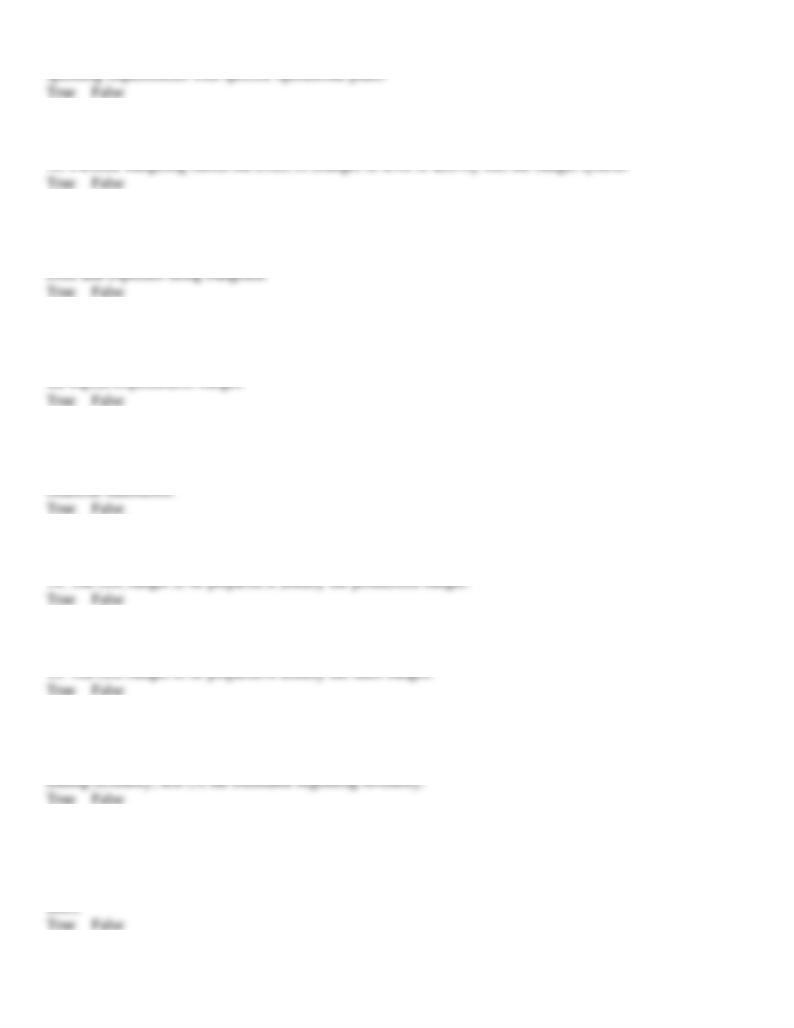
9. Budgetary slack can be avoided if lower and mid-level managers are requested to support all of their
11. In preparing flexible budgets, the first step is to identify the fixed and variable components of the various
12. The master budget of a small manufacturer would normally include all necessary component budgets except
13. The master budget of a small manufacturer would normally include all component budgets that impact the
16. The budgeted volume of production is based on the sum of (1) the expected sales volume and (2) the desired
17. If Division Inc. expects to sell 200,000 units in 2012, desires ending inventory of 24,000 units, and has
22,000 units on hand as of the beginning of the year, the budgeted volume of production for 2012 is 198,000

18. If Division Inc. expects to sell 300,000 units in 2012, desires ending inventory of 22,000 units, and has
24,000 units on hand as of the beginning of the year, the budgeted volume of production for 2012 is 298,000
19. The budgeted volume of production is normally computed as the sum of (1) the expected sales volume and
20. The budgeted direct materials purchases are based on the sum of (1) the materials needed for production and
21. The budgeted direct materials purchases are normally computed as the sum of (1) the materials for
24. Supervisor salaries, maintenance, and indirect factory wages would normally appear in the factory overhead
25. Supervisor salaries, maintenance, and indirect factory wages would normally appear in the selling and
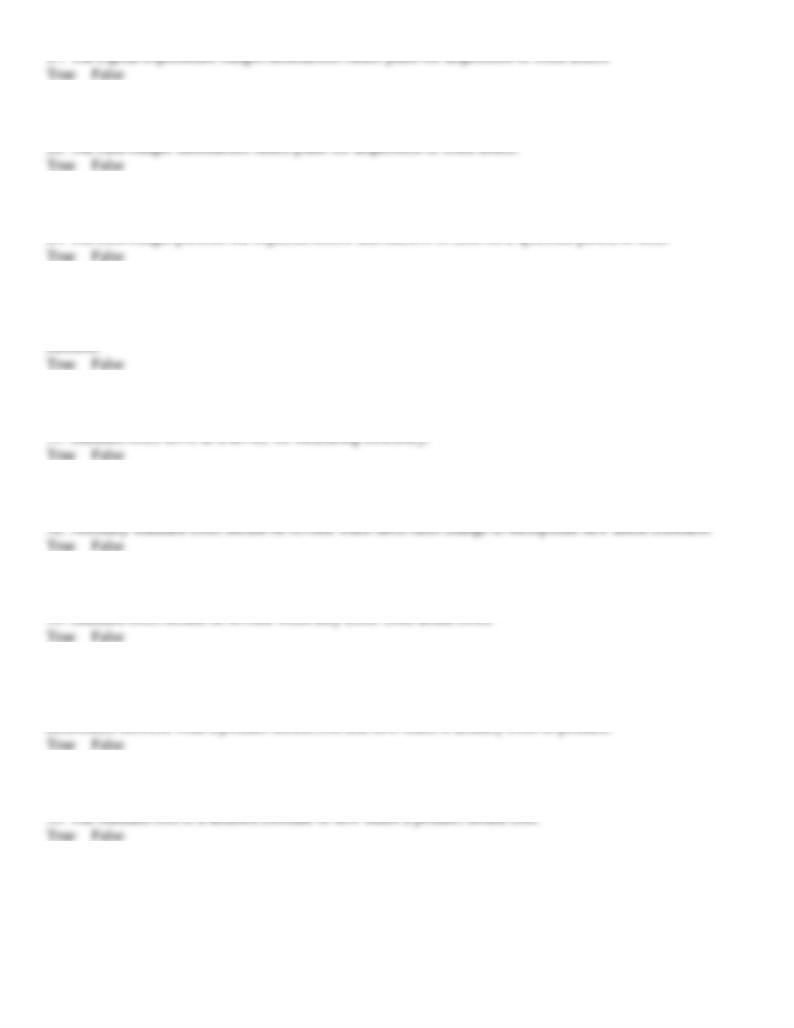
30. A variable cost system is an accounting system where standards are set for each manufacturing cost
34. As a device for measuring efficiency, standard cost systems enables management to determine the causes of
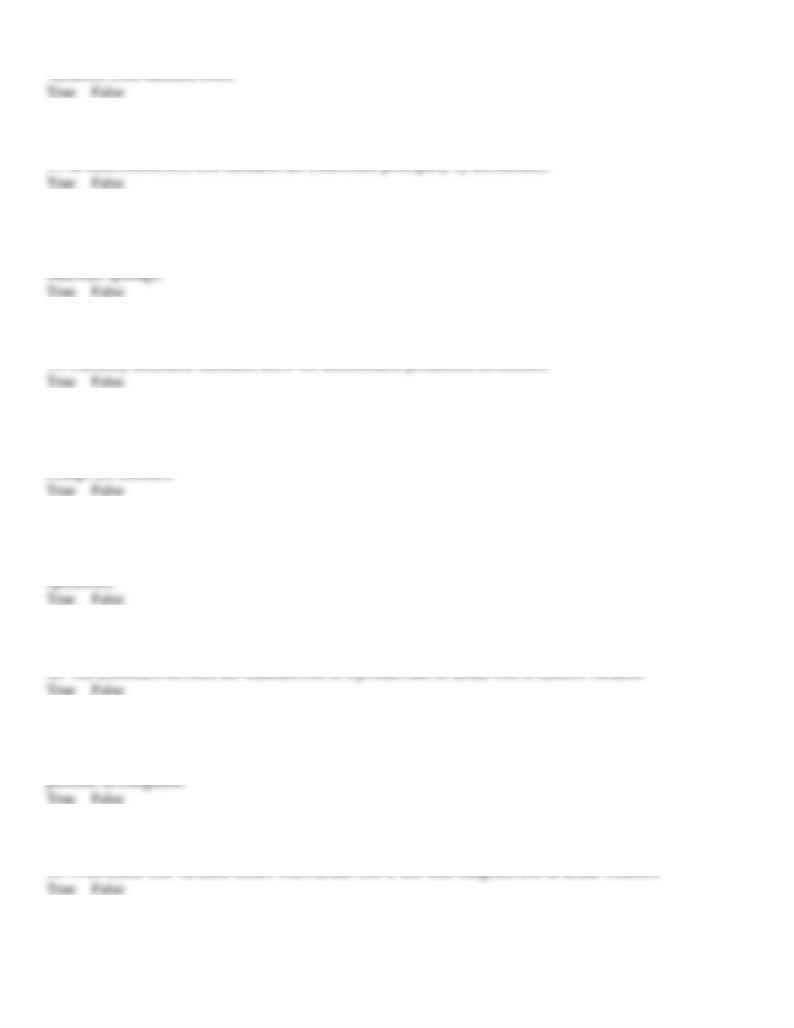
36. Financial reporting systems that are guided by the principle of exceptions concept focus attention on
38. Ideal standards are developed under conditions that assume no idle time, no machine breakdowns, and no
40. The fact that workers are unable to meet a properly determined direct labor standard is sufficient cause to
41. Changes in technology, machinery, or production methods may make past cost data irrelevant for future
43. A budget performance report compares actual results with the budgeted amounts and reports differences for

47. If the standard to produce a given amount of product is 500 direct labor hours at $15 and the actual was 600
48. If the standard to produce a given amount of product is 500 direct labor hours at $15 and the actual was 600
49. If the standard to produce a given amount of product is 2,000 units of direct materials at $12 and the actual
50. If the standard to produce a given amount of product is 900 units of direct materials at $11 and the actual
51. If the standard to produce a given amount of product is 1,000 units of direct materials at $11 and the actual
52. If the standard to produce a given amount of product is 1,000 units of direct materials at $11 and the actual
53. If the standard to produce a given amount of product is 1,000 units of direct materials at $11 and the actual
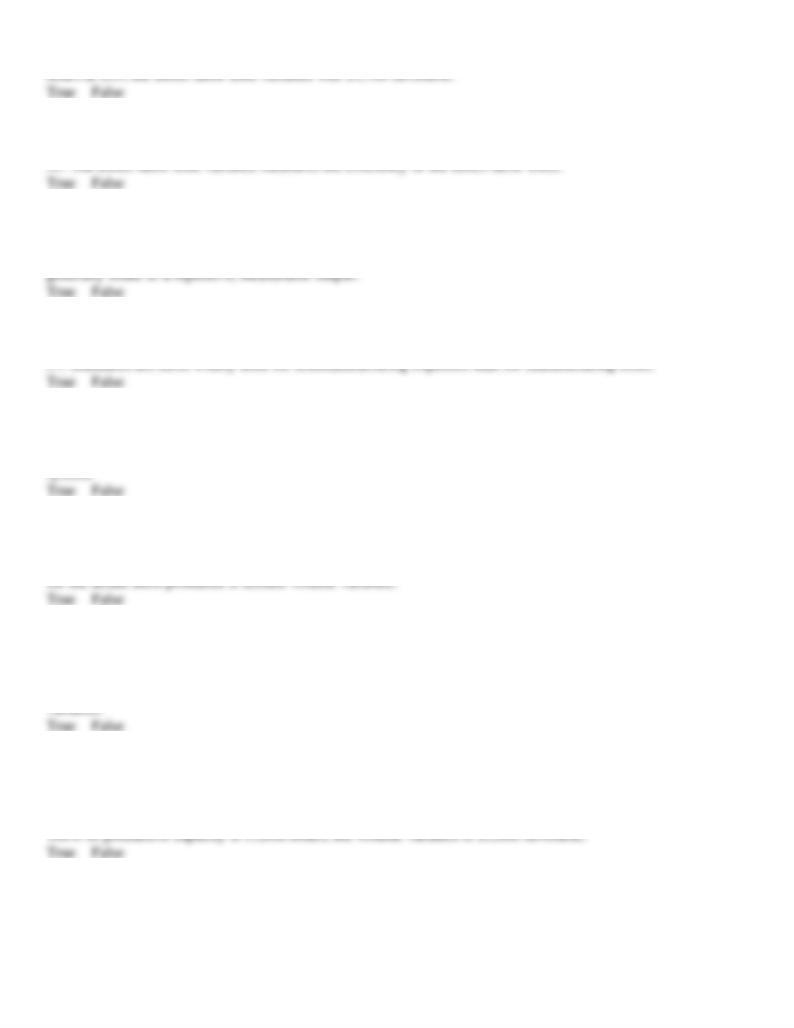
54. If the standard to produce a given amount of product is 600 direct labor hours at $17 and the actual was 500
56. Using a standard costing system for nonmanufacturing expenses is easily administered because the expenses
58. Nonmanufacturing activities are usually controlled using a static budget rather than a standard costing
59. The difference between the budgeted fixed overhead at 100% of normal capacity and the standard fixed cost
60. The difference between the actual amount of variable factory overhead cost incurred and the amount of
variable factory overhead budgeted for the standard product is termed as variable factory overhead controllable
61. If the standard to produce certain quantity of product is 16,000 hours at a factory overhead rate of $5 ($3
fixed, $2 variable), actual variable factory overhead is $26,400, actual fixed factory overhead is $45,000, and

62. If the standard to produce a given amount of product is 12,000 hours at a factory overhead rate of $5 ($3
fixed, $2 variable), actual variable factory overhead was $26,400, actual fixed factory overhead was $45,000,
63. The most effective means of presenting standard factory overhead cost variance data is through a selling
64. The most effective means of presenting standard factory overhead cost variance data is through a factory
65. Since the controllable variance measures the efficiency of using variable overhead resources, if budgeted
67. Favorable volume variances are never harmful since achieving them encourages managers to run the factory
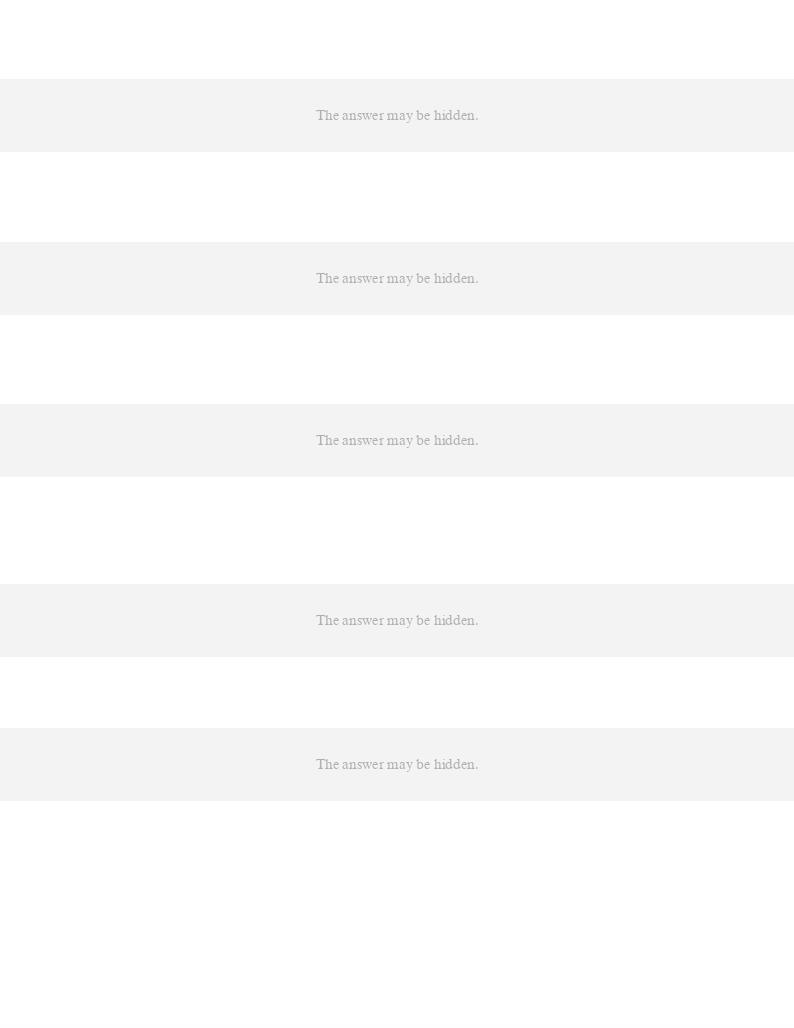
69. Department managers plan lower goals than possible in order to build in a cushion for unexpected events.
70. The process of developing budget estimates by requiring all levels of management to estimate sales,
71. A variant of fiscal-year budgeting whereby a twelve-month projection into the future is maintained at all
72. Christiansen and Sons' static budget for 10,000 units of production includes $50,000 for direct materials,
$44,000 for direct labor, utilities of $5,000, and supervisor salaries of $15,000. A flexible budget for 12,000
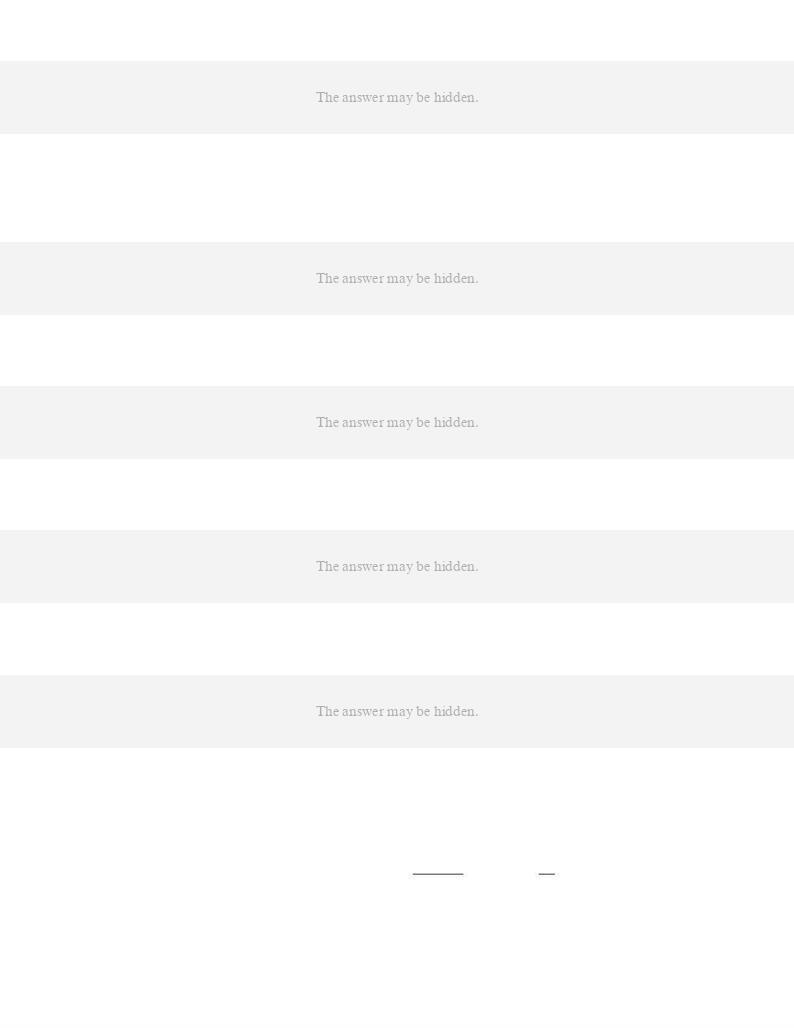
75. For February, sales revenue is $250,000; sales commissions are 6% of sales; the sales manager's salary is
$50,000; advertising expenses are $15,000; shipping expenses total 1% of sales; and miscellaneous selling
79. Below is budgeted production and sales information for Cooper Cans, Inc. for the month of March:
Aluminum
Tin
Estimated beginning inventory
10,000 units
4,000 units
Desired ending inventory
14,000 units
3,000 units
Region I, anticipated sales
360,000 units
80,000 units
Region II, anticipated sales
120,000 units
20,000 units

A. $63,000.
B. $62,750.
C. $63,250.
D. $66,450.
80. Below is budgeted production and sales information for Cooper Cans, Inc. for the month of March:
Aluminum
Tin
Estimated beginning inventory
10,000 units
4,000 units
Desired ending inventory
14,000 units
3,000 units
Region I, anticipated sales
360,000 units
80,000 units
Region II, anticipated sales
120,000 units
20,000 units
A. 476,000 units.
B. 484,000 units.
C. 480,000 units.
D. 504,000 units.
81. Below is budgeted production and sales information for Cooper Cans, Inc. for the month of March:
Aluminum
Tin
Estimated beginning inventory
10,000 units
4,000 units
Desired ending inventory
14,000 units
3,000 units
Region I, anticipated sales
360,000 units
80,000 units
Region II, anticipated sales
120,000 units
20,000 units
A. 99,000 units.
B. 101,000 units.
C. 100,000 units.
D. 107,000 units.
82. Cape Corporation sells a single product. Budgeted sales for the year are anticipated to be 640,000 units,
estimated beginning inventory is 98,000 units, and desired ending inventory is 80,000 units. The quantities of
direct materials expected to be used for each unit of finished product are given below.
Material A
.50 lb. per unit
@ $0.60 per pound
Material B
1.00 lb. per unit
@ $1.70 per pound
Material C
1.20 lb. per unit
@ $1.00 per pound
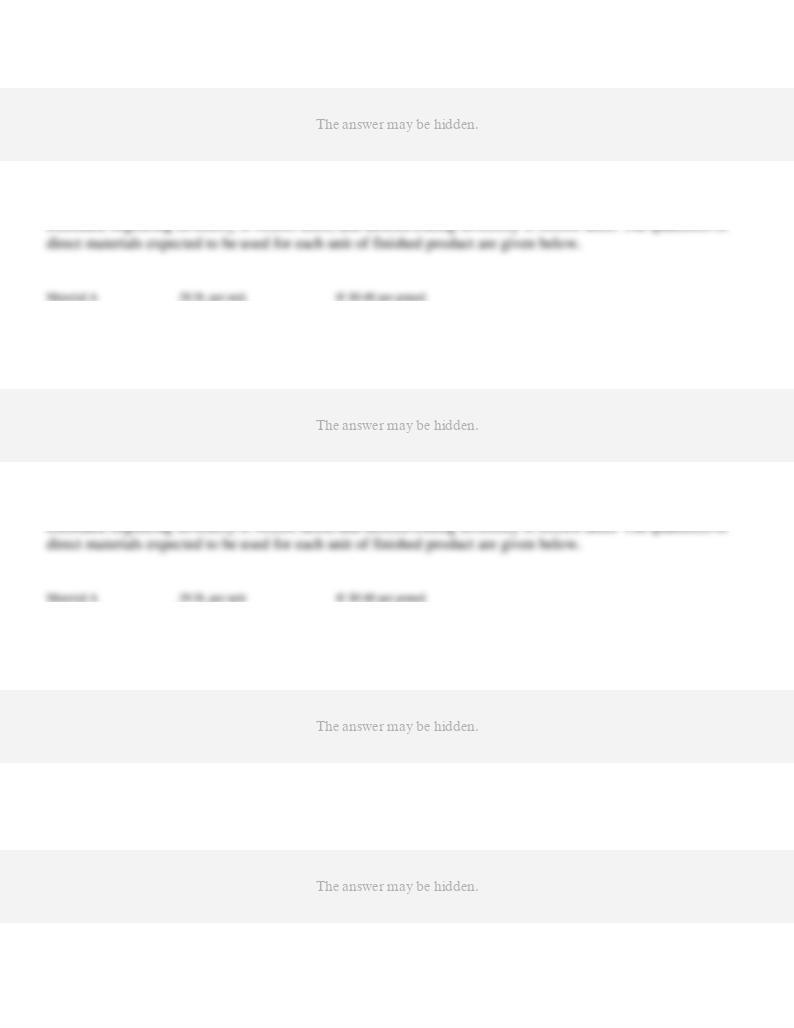
83. Cape Corporation sells a single product. Budgeted sales for the year are anticipated to be 640,000 units,
Material B
1.00 lb. per unit
@ $1.70 per pound
Material C
1.20 lb. per unit
@ $1.00 per pound
84. Cape Corporation sells a single product. Budgeted sales for the year are anticipated to be 640,000 units,
Material B
1.00 lb. per unit
@ $1.70 per pound
Material C
1.20 lb. per unit
@ $1.00 per pound
85. If the expected sales volume for the current period is 22,000 units, the desired ending inventory is 800 units,
and the beginning inventory is 500 units, the number of units set forth in the production budget, representing
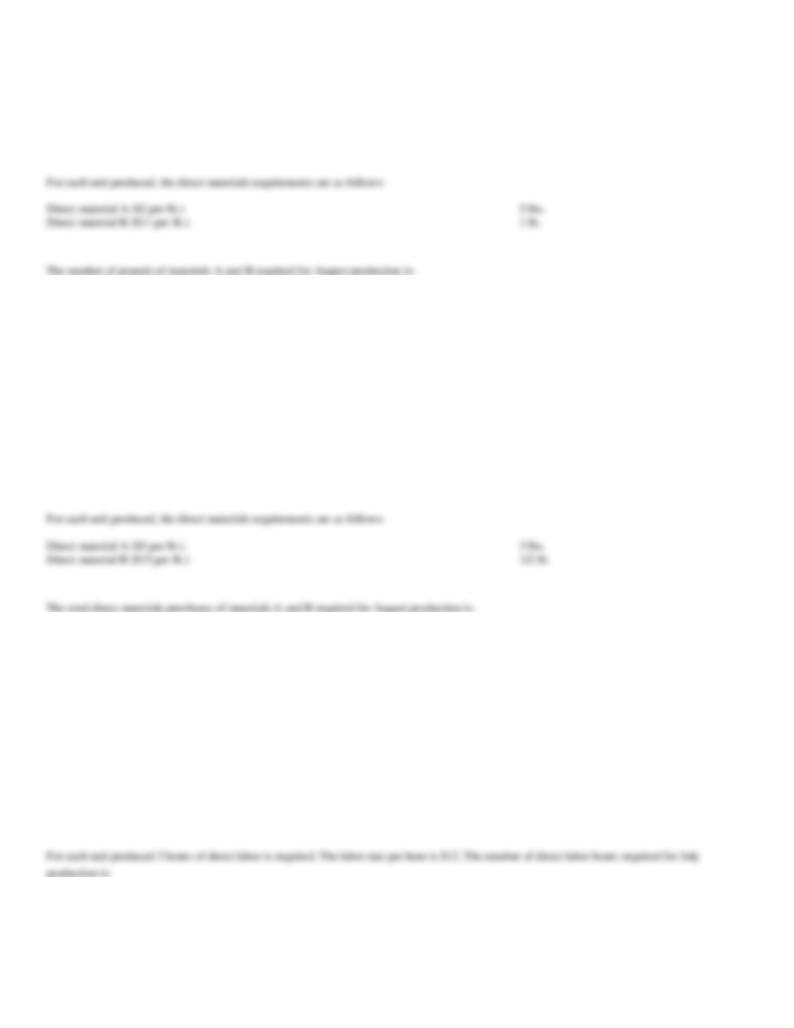
86. Production estimates for August are as follows:
Estimated inventory (units), August 1
3,000
Desired inventory (units), August 31
2,000
Expected sales volume (units), August
40,000
A. 195,000 lbs. of A; 39,000 lbs. of B.
B. 200,000 lbs. of A; 40,000 lbs. of B.
C. 205,000 lbs. of A; 41,000 lbs. of B.
D. 210,000 lbs. of A; 42,000 lbs. of B.
87. Production estimates for August are as follows:
Estimated inventory (units), August 1
12,000
Desired inventory (units), August 31
9,000
Expected sales volume (units), August
75,000
A. $1,260,000 for A; $630,000 for B.
B. $1,080,000 for A; $540,000 for B.
C. $1,125,000 for A; $562,500 for B.
D. $1,170,000 for A; $585,000 for B.
88. Production estimates for July are as follows:
Estimated inventory (units), July 1
650
Desired inventory (units), July 31
1,050
Expected sales volume (units), July
7,600
A. 24,000.
B. 21,600.
C. 22,800.
D. 25,950.
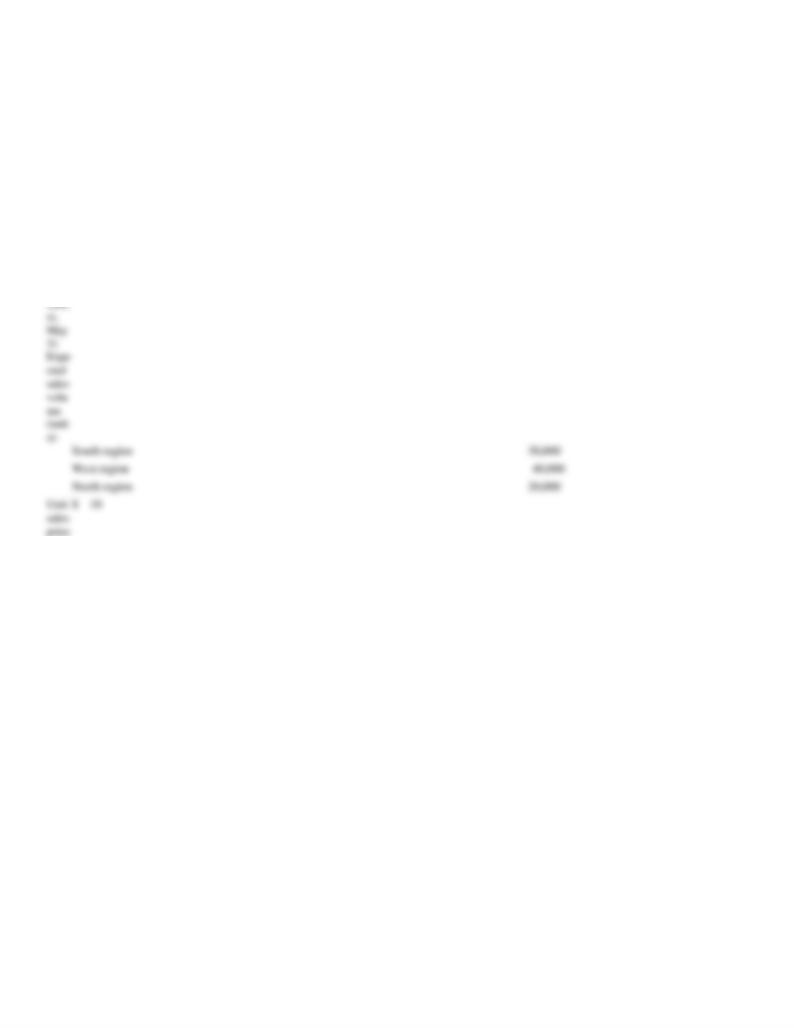
89. Based on the following production and sales estimates for May, determine the number of units expected to
be manufactured in May.
Esti
mate
d
inve
ntory
(unit
s),
May
1
20,000
Desir
ed
inve
ntory
15,000
A. 85,000 units
B. 90,000 units
C. 95,000 units
D. 105,000 units
90. Which of the following budgets provides the starting point for the preparation of the direct labor cost
budget?
A. Direct materials purchases budget
B. Cash budget
C. Production budget
D. Factory overhead budget
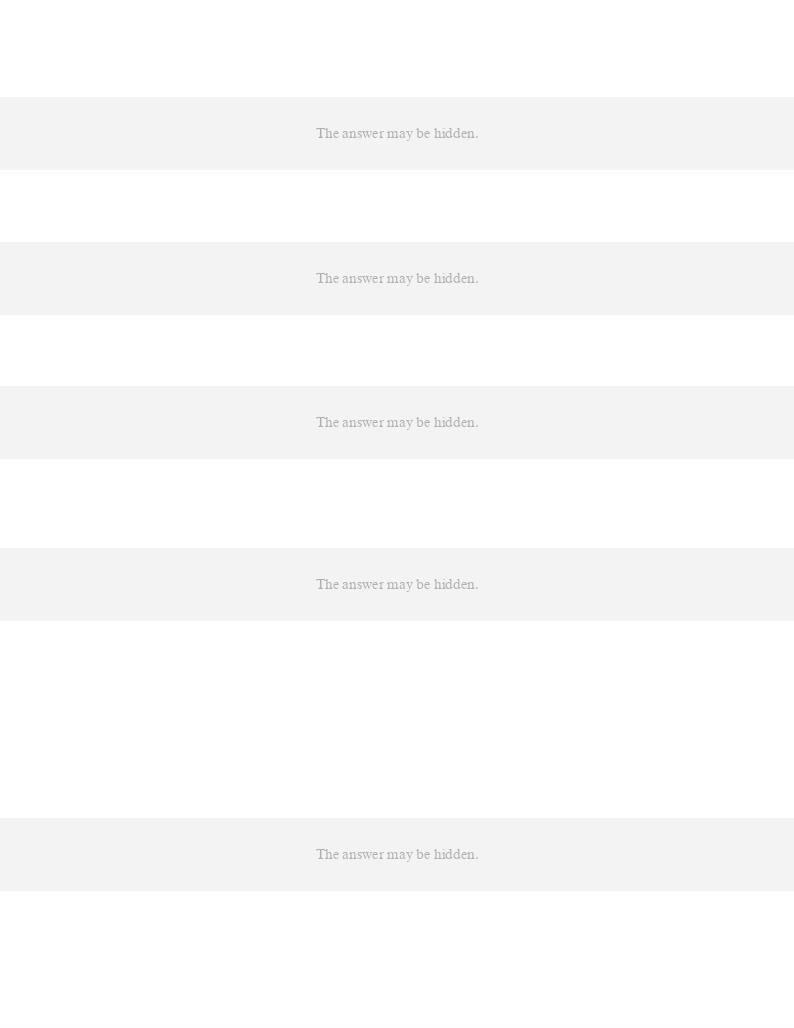
91. If the expected sales volume for the current period is 7,000 units, the desired ending inventory is 400 units,
and the beginning inventory is 300 units, the number of units set forth in the production budget, representing
94. For which of the following reasons, management accountants usually provide for a minimum cash balance
95. Benjamin Corporation began its operations on September 1 of the current year. Budgeted sales for the first
three months of business are $250,000, $300,000, and $420,000, respectively, for September, October, and
November. The company expects to sell 20% of its merchandise for cash. Of sales on account, 70% are
expected to be collected in the month of the sale, 25% in the month following the sale, and the remainder in the
following month.
Refer to the information provided for Benjamin Corporation. The cash collections from accounts receivable in

96. Benjamin Corporation began its operations on September 1 of the current year. Budgeted sales for the first
three months of business are $250,000, $300,000, and $420,000, respectively, for September, October, and
November. The company expects to sell 20% of its merchandise for cash. Of sales on account, 70% are
expected to be collected in the month of the sale, 25% in the month following the sale, and the remainder in the
following month.
Refer to the information provided for Benjamin Corporation. The cash collections from accounts receivable in
97. Benjamin Corporation began its operations on September 1 of the current year. Budgeted sales for the first
three months of business are $250,000, $300,000, and $420,000, respectively, for September, October, and
November. The company expects to sell 20% of its merchandise for cash. Of sales on account, 70% are
expected to be collected in the month of the sale, 25% in the month following the sale, and the remainder in the
following month.
Refer to the information provided for Benjamin Corporation. The cash collections from accounts receivable in
98. Kohlman Company began its operations on March 31 of the current year. Projected manufacturing costs for
the first three months of business are $156,800, $195,200, and $217,600, respectively, for April, May, and June.
Depreciation, insurance, and property taxes represent $28,800 of the estimated monthly manufacturing costs.
Insurance was paid on March 31, and property taxes will be paid in November. Three-fourths of the remainder
of the manufacturing costs are expected to be paid in the month in which they are incurred with the balance to
be paid in the following month.
Refer to the information provided for Kohlman Company. The cash payments for manufacturing in the month
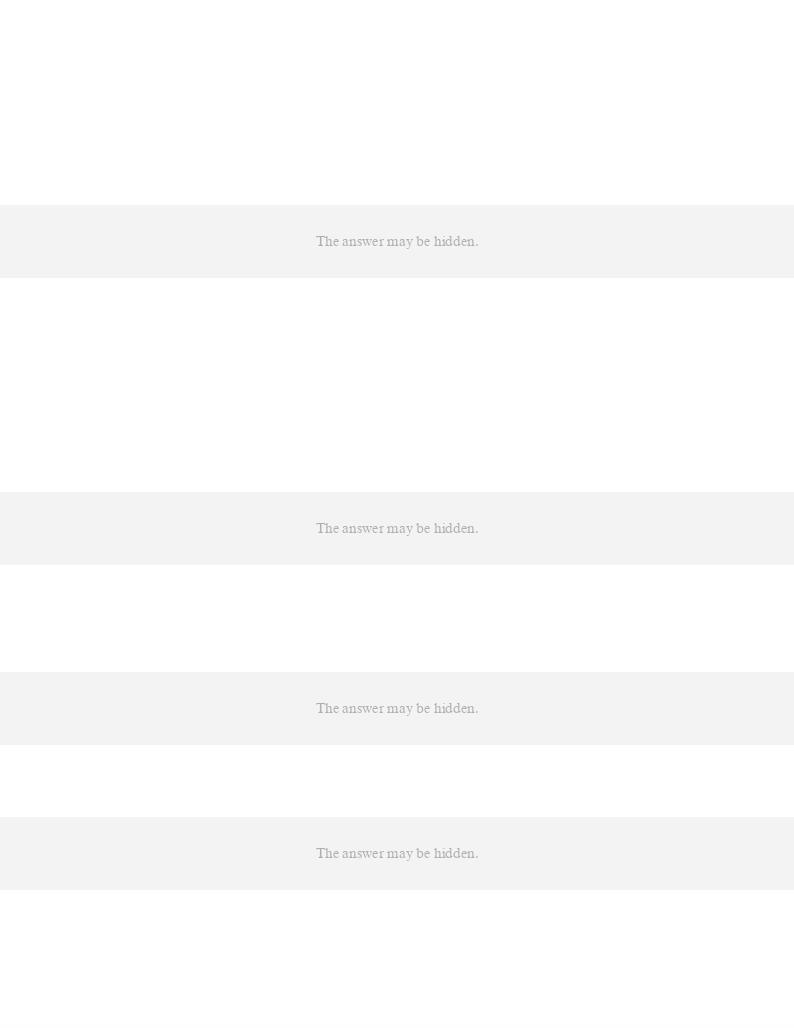
99. Kohlman Company began its operations on March 31 of the current year. Projected manufacturing costs for
the first three months of business are $156,800, $195,200, and $217,600, respectively, for April, May, and June.
Depreciation, insurance, and property taxes represent $28,800 of the estimated monthly manufacturing costs.
Insurance was paid on March 31, and property taxes will be paid in November. Three-fourths of the remainder
of the manufacturing costs are expected to be paid in the month in which they are incurred with the balance to
be paid in the following month.
Refer to the information provided for Kohlman Company. The cash payments for manufacturing in the month
100. Kohlman Company began its operations on March 31 of the current year. Projected manufacturing costs
for the first three months of business are $156,800, $195,200, and $217,600, respectively, for April, May, and
June. Depreciation, insurance, and property taxes represent $28,800 of the estimated monthly manufacturing
costs. Insurance was paid on March 31, and property taxes will be paid in November. Three-fourths of the
remainder of the manufacturing costs are expected to be paid in the month in which they are incurred with the
balance to be paid in the following month.
Refer to the information provided for Kohlman Company. The cash payments for manufacturing in the month
101. McCabe Manufacturing Co.'s static budget at 8,000 units of production includes $40,000 for direct labor
and $4,000 for electric power. Total fixed costs are $23,000. At 9,000 units of production, a flexible budget
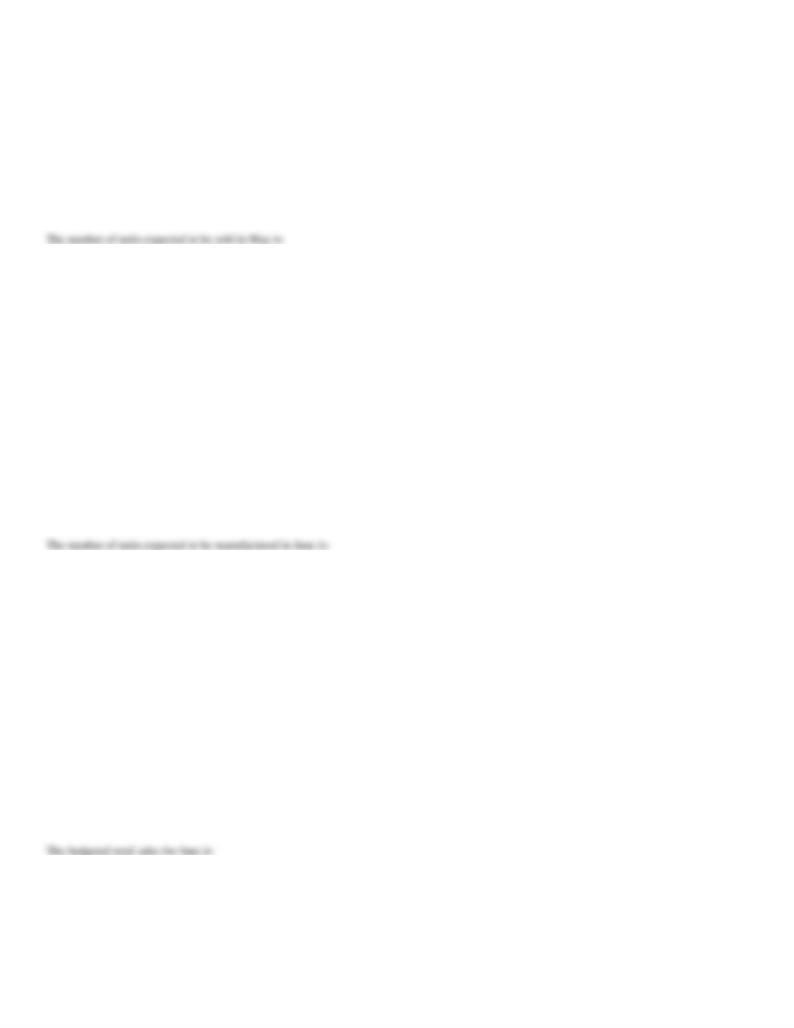
103. Production and sales estimates for May for the Hudson Co. are as follows:
Estimated inventory (units), May 1
17,500
Desired inventory (unit), May 31
19,300
Expected sales volume (units):
Area W
4,200
Area X
7,000
Area Y
9,000
Unit sales price
$15
A. 22,000.
B. 18,400.
C. 23,800.
D. 20,200.
104. Production and sales estimates for June are as follows:
Estimated inventory (units), June 1
18,500
Desired inventory (units), June 30
19,000
Expected sales volume (units):
Area X
3,000
Area Y
4,000
Area Z
5,500
Unit sales price
$20
A. 10,000.
B. 12,000.
C. 13,000.
D. 12,500.
105. Production and sales estimates for June are as follows:
Estimated inventory (units), June 1
8,000
Desired inventory (units), June 30
9,000
Expected sales volume (units):
Area X
3,000
Area Y
4,000
Area Z
5,500
Unit sales price
$25
A. $300,000.
B. $337,500.
C. $312,500.
D. $287,500.

106. As of January 1 of the current year, the Butner Company had accounts receivables of $50,000. Sales for
January, February, and March were as follows: $120,000, $140,000, and $150,000. 20% of each month’s sales
are for cash. Of the remaining 80% (the credit sales), 60% are collected in the month of sale, with the remaining
40% collected in the following month. What is the total cash collected (both from accounts receivable and for
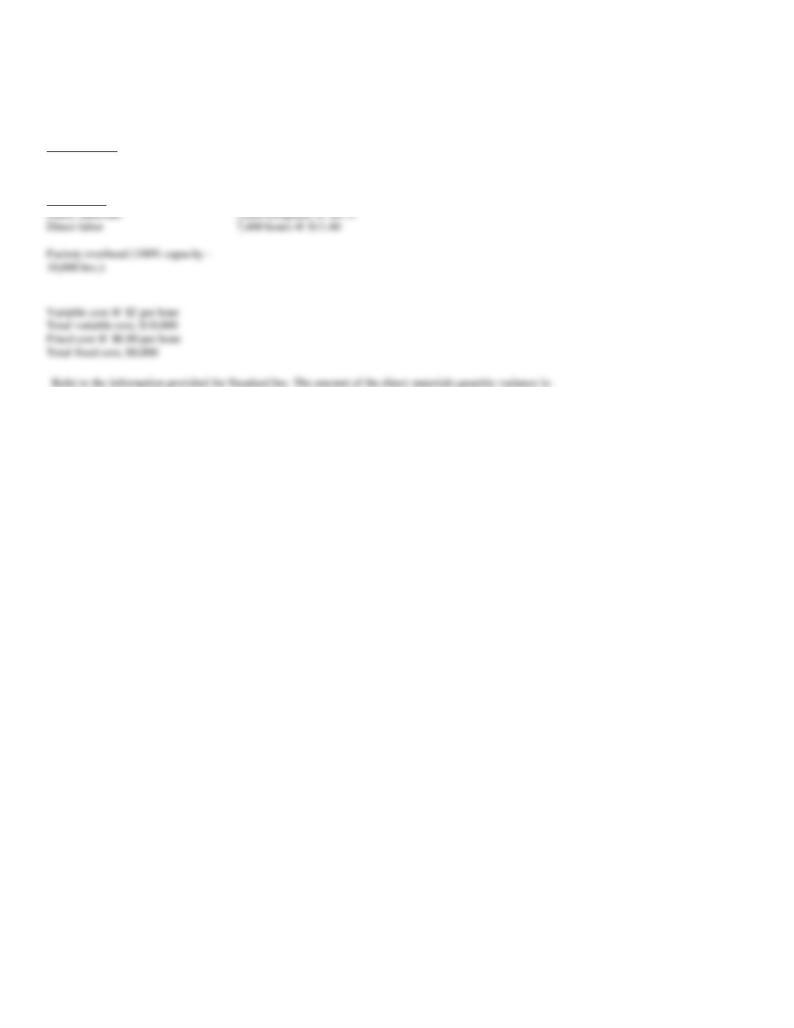
111. Following is the information about Standard Inc.
The standard costs and actual costs for direct materials, direct labor, and factory overhead for the manufacture
of 2,500 units of product are as follows:
Standard Costs
Direct materials
2,500 kilograms @ $8
Direct labor
7,500 hours @ $12
Actual Costs
A. $875 favorable.
B. $875 unfavorable.
C. $800 favorable.
D. $800 unfavorable.
112. The following data relate to direct materials costs of Texas Inc. for November:
Actual costs
4,500 pounds at $6.00
Standard costs
4,600 pounds at $5.50
Refer to the information provided for Texas Inc. What is the direct materials price variance?
A. $2,250 unfavorable
B. $2,250 favorable
C. $2,300 unfavorable
D. $1,700 unfavorable
113. The following data relate to direct materials costs of Texas Inc. for November:
Actual costs
4,500 pounds at $6.00
Standard costs
4,600 pounds at $5.50
Refer to the information provided for Texas Inc. What is the direct materials quantity variance?
A. $550 unfavorable
B. $550 favorable
C. $600 favorable
D. $600 unfavorable
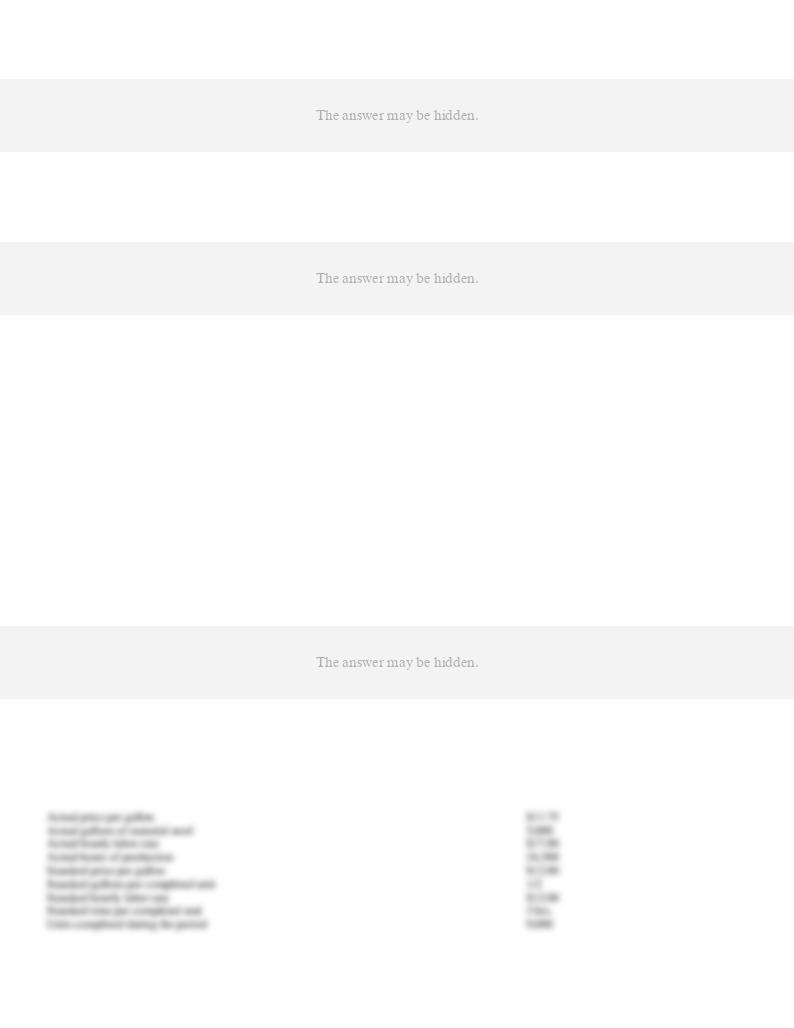
114. If the actual quantity of direct materials used in producing a commodity differs from the standard quantity,
115. If the price paid per unit differs from the standard price per unit for direct materials, the variance is
116. Efficient Corporation uses a standard cost system. The following information was provided for the period
that just ended:
Actual price per gallon
$11.75
Actual gallons of material used
5,000
Actual hourly labor rate
$17.00
Actual hours of production
24,300
Standard price per gallon
$12.00
Standard gallons per completed unit
1/2
Standard hourly labor rate
$12.00
Standard time per completed unit
3 hrs.
Units completed during the period
9,000
117. Efficient Corporation uses a standard cost system. The following information was provided for the period
that just ended:
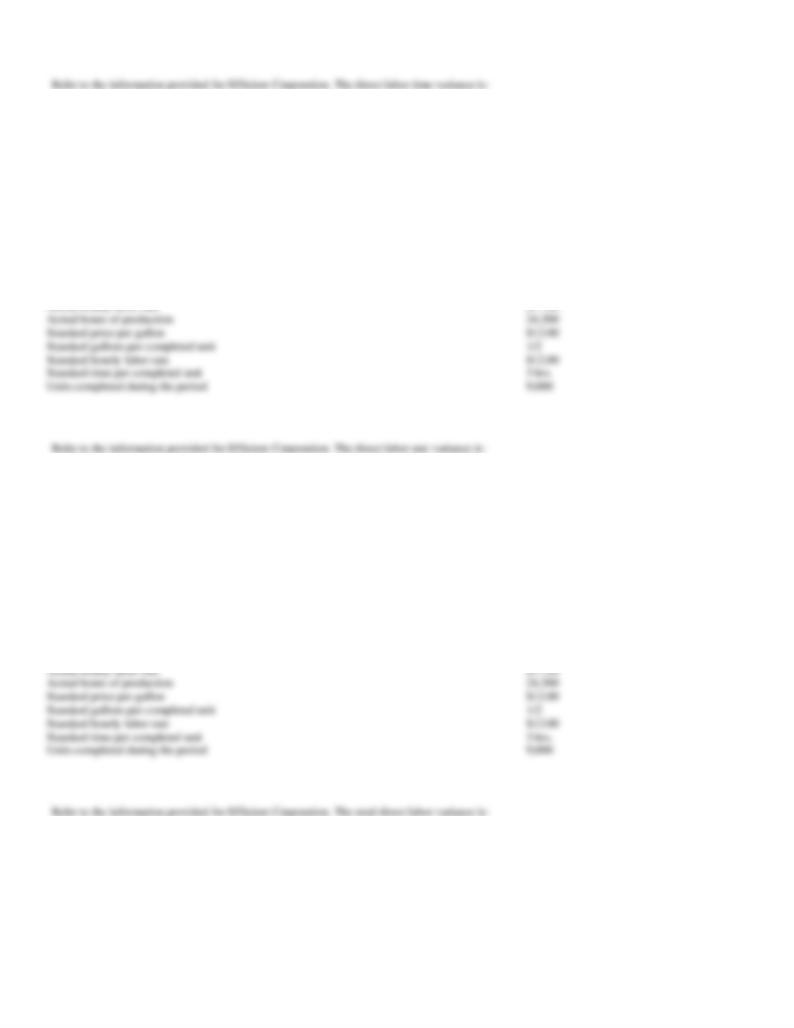
A. $31,725 favorable.
B. $32,400 favorable.
C. $89,100 unfavorable.
D. $121,500 unfavorable.
118. Efficient Corporation uses a standard cost system. The following information was provided for the period
that just ended:
Actual price per gallon
$11.75
Actual gallons of material used
5,000
A. $135,000 unfavorable.
B. $89,100 favorable.
C. $89,100 unfavorable.
D. $121,500 unfavorable.
119. Efficient Corporation uses a standard cost system. The following information was provided for the period
that just ended:
Actual price per gallon
$11.75
Actual gallons of material used
5,000
A. $216,000 favorable.
B. $32,400 favorable.
C. $89,100 unfavorable.
D. $121,500 unfavorable.

120. Frogue Corporation uses a standard cost system. The following information was provided for the period
that just ended:
Actual price per kilogram
$2.50
Actual kilograms of material used
31,000
Actual hourly labor rate
$18.10
Actual hours of production
4,900 labor hrs.
Standard price per kilogram
$2.80
A. $6,500 unfavorable.
B. $9,000 unfavorable.
C. $9,000 favorable.
D. $6,500 favorable.
121. Frogue Corporation uses a standard cost system. The following information was provided for the period
that just ended:
Actual price per kilogram
$2.50
Actual kilograms of material used
31,000
Actual hourly labor rate
$18.10
Actual hours of production
4,900 labor hrs.
Standard price per kilogram
$2.80
A. $6,000 favorable.
B. $2,100 favorable.
C. $2,100 unfavorable.
D. $6,000 unfavorable.

122. Frogue Corporation uses a standard cost system. The following information was provided for the period
that just ended:
Actual price per kilogram
$2.50
Actual kilograms of material used
31,000
Actual hourly labor rate
$18.10
Actual hours of production
4,900 labor hrs.
Standard price per kilogram
$2.80
Standard kilograms per completed unit
6 kilograms
Standard hourly labor rate
$18.00
Standard time per completed unit
1 hr.
Actual total factory overhead
$34,900
Actual fixed factory overhead
$18,000
Standard fixed factory overhead rate
$1.20 per labor hour
Standard variable factory overhead rate
$3.80 per labor hour
Maximum plant capacity
15,000 hours
Units completed during the period
5,000
123. If the wage rate paid per hour differs from the standard wage rate per hour for direct labor, the variance is
124. If the actual direct labor hours spent producing a commodity differ from the standard hours, the variance is
125. The following data relate to direct labor costs for the current period of Executive Inc.:
Standard costs
6,000 hours at $12.00
Actual costs
7,500 hours at $11.60
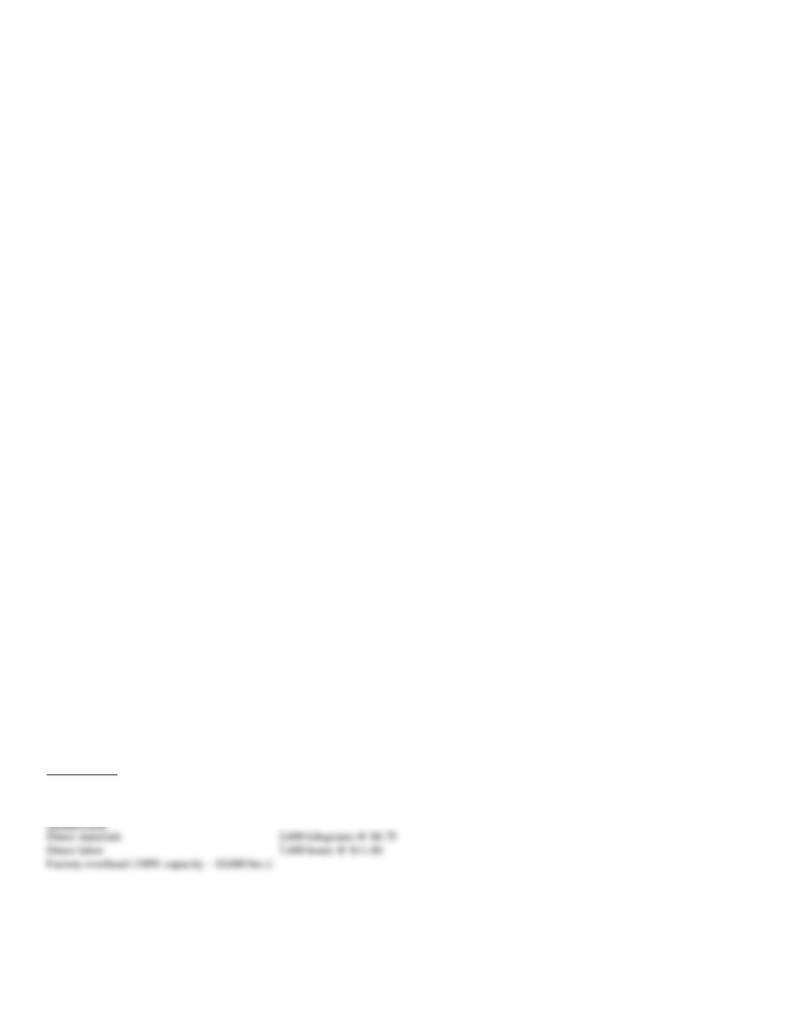
Refer to the information provided for Executive Inc. What is the direct labor time variance?
A. $17,400 favorable
B. $17,400 unfavorable
C. $18,000 favorable
D. $18,000 unfavorable
126. The following data relate to direct labor costs for the current period of Executive Inc.:
Standard costs
6,000 hours at $12.00
Actual costs
7,500 hours at $11.60
Refer to the information provided for Executive Inc. What is the direct labor rate variance?
A. $3,000 unfavorable
B. $3,000 favorable
C. $2,400 unfavorable
D. $2,400 favorable
127. The following data relate to direct labor costs for the current period:
Standard costs
36,000 hours at $23.50
Actual costs
35,000 hours at $23.00
What is the direct labor time variance?
A. $23,000 unfavorable
B. $23,500 unfavorable
C. $23,500 favorable
D. $23,000 favorable
128. Answer Corporation uses standard cost system. The standard costs and actual costs for direct materials,
direct labor, and factory overhead for the manufacture of 2,500 units of product are as follows:
Standard Costs
Direct materials
2,500 kilograms @ $8
Direct labor
7,500 hours @ $12
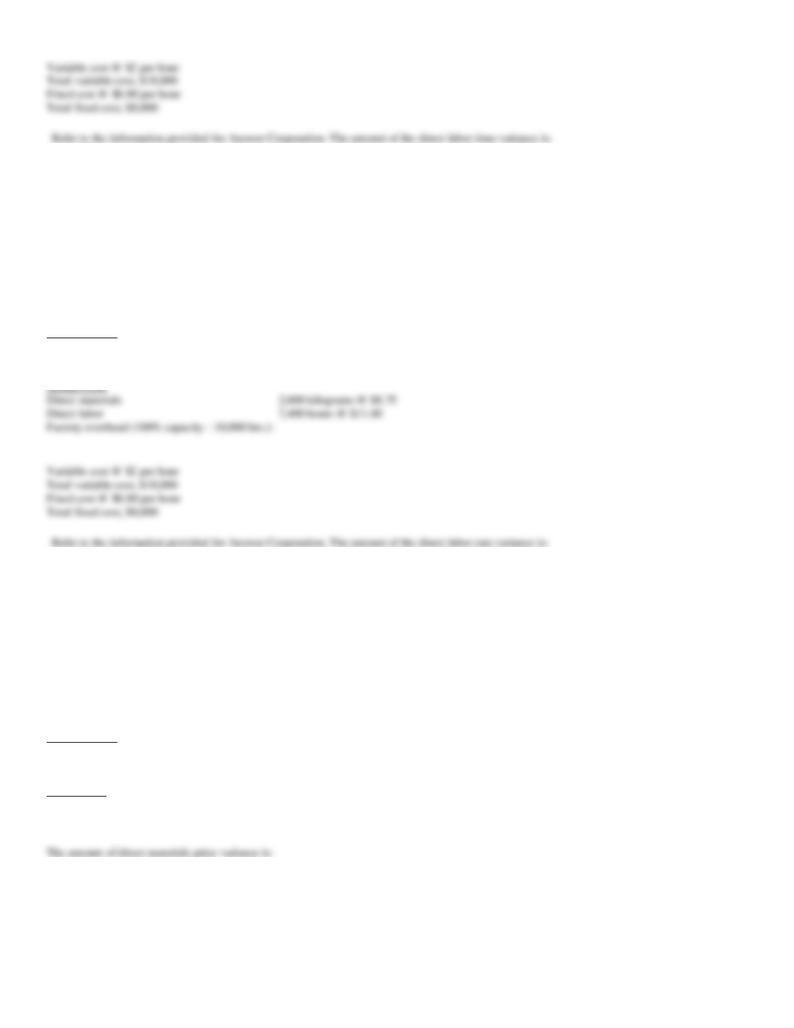
A. $1,200 favorable.
B. $1,140 unfavorable.
C. $1,200 unfavorable.
D. $1,140 favorable.
129. Answer Corporation uses standard cost system. The standard costs and actual costs for direct materials,
direct labor, and factory overhead for the manufacture of 2,500 units of product are as follows:
Standard Costs
Direct materials
2,500 kilograms @ $8
Direct labor
7,500 hours @ $12
A. $4,440 unfavorable.
B. $4,500 favorable.
C. $4,440 favorable.
D. $4,500 unfavorable.
130. The standard costs and actual costs for direct materials for the manufacture of 2,500 actual units of product
are as follows:
Standard Costs
Direct materials (per completed unit)
1.04 kilograms @$8.75
Actual Costs
Direct materials
2,500 kilograms @ $8
A. $1,875 unfavorable.
B. $1,950 favorable.
C. $1,875 favorable.
D. $1,950 unfavorable.
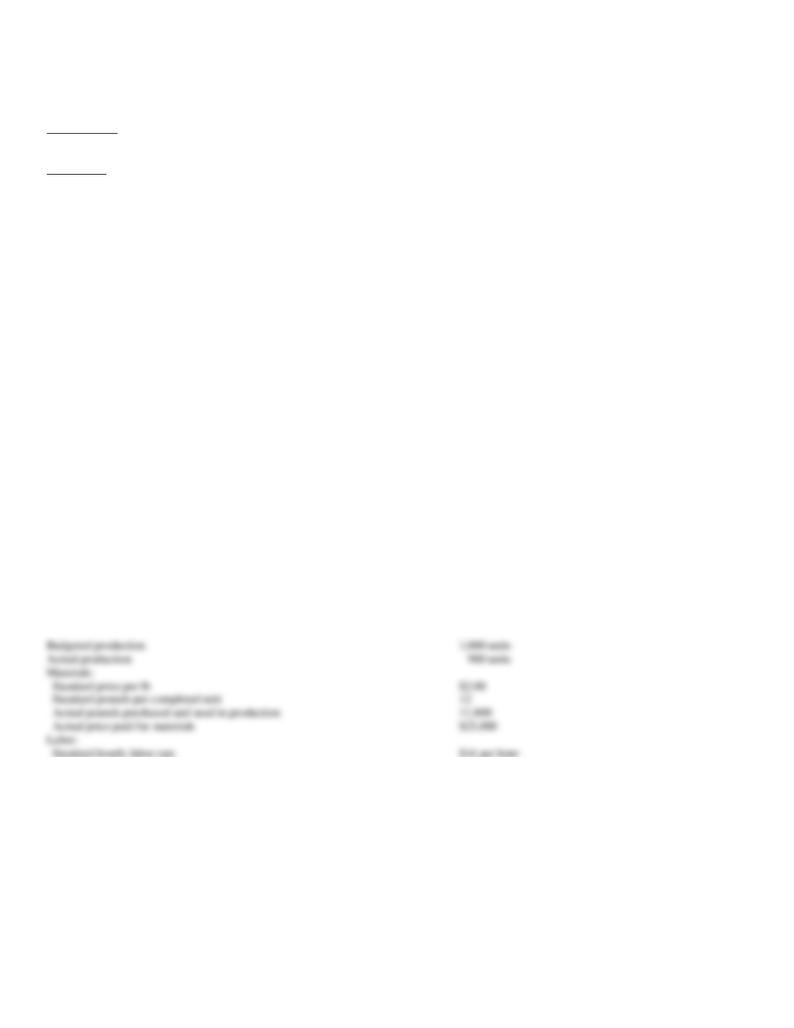
131. The standard costs and actual costs for direct materials, direct labor, and factory overhead for the
manufacture of 2,500 units of product are as follows:
Standard Costs
Direct labor
7,500 hours @ $12
Actual Costs
Direct labor
7,400 hours @ $11.40
The amount of the direct labor time variance is:
A. $1,200 favorable.
B. $1,140 unfavorable.
C. $1,200 unfavorable.
D. $1,140 favorable.
132. The following data relate to direct labor costs for the current period:
Standard costs
9,000 hours at $5.50
Actual costs
8,750 hours at $5.25
What is the direct labor rate variance?
A. $2,250.00 unfavorable
B. $2,187.50 unfavorable
C. $2,250.00 favorable
D. $2,187.50 favorable
133. The following data is given for the Walker Company:
Standard hours allowed per completed unit
4.5
Actual labor hours worked
4,560
Actual total labor costs
$62,928
Overhead:
Actual and budgeted fixed overhead
$27,000
Standard variable overhead rate
$3.50 per standard direct labor hour
Actual variable overhead costs
$15,500
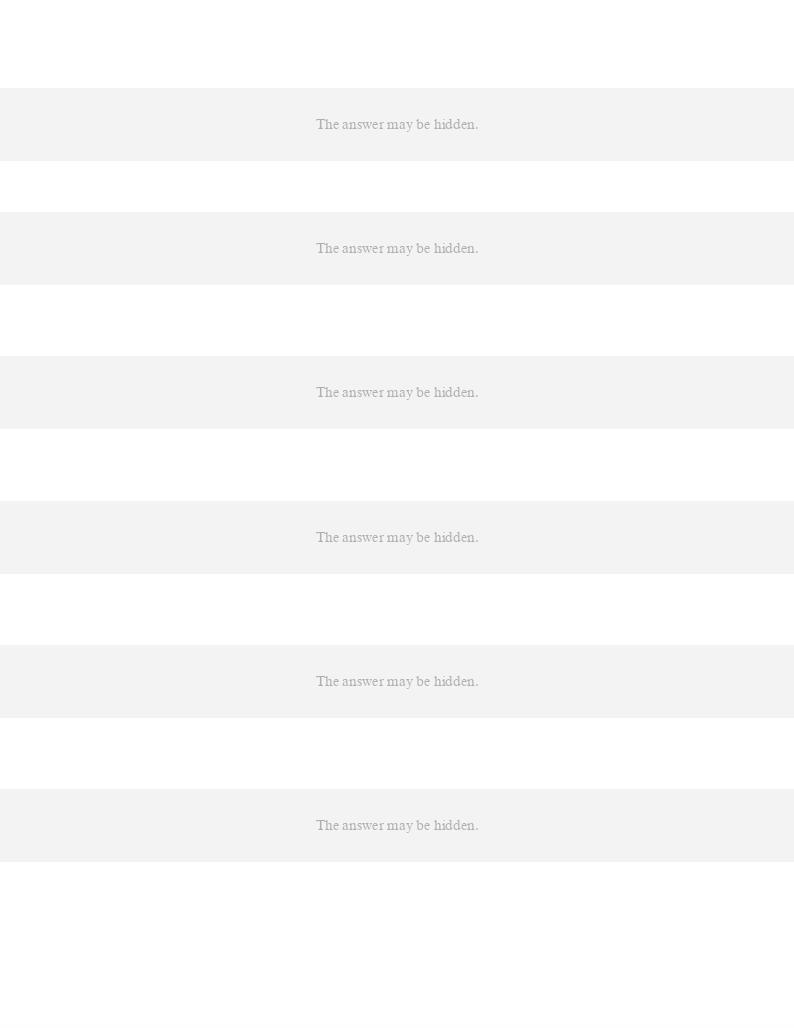
Overhead is applied on standard labor hours.
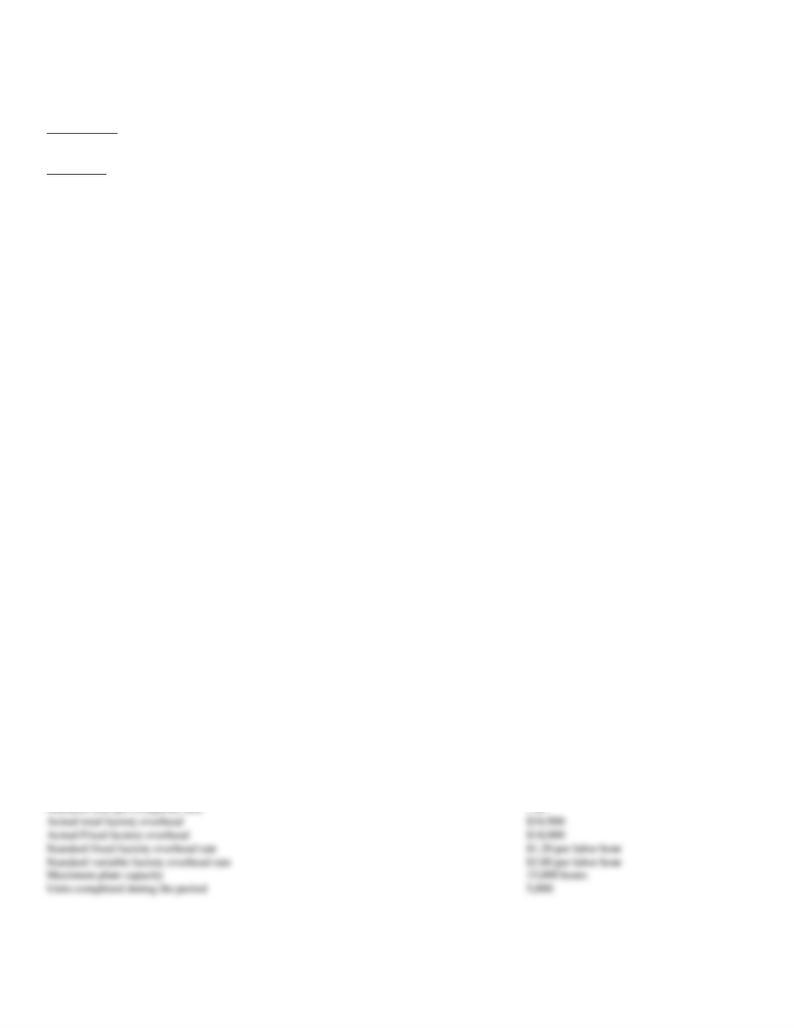
139. The standard costs and actual costs for direct labor for the manufacture of 2,500 actual units of product are
as follows:
Standard Costs
Direct labor
7,500 hours @ $12
Actual Costs
Direct labor
7,400 hours @ $11.40
The amount of the direct labor rate variance is:
A. $4,440 unfavorable.
B. $4,500 favorable.
C. $4,440 favorable.
D. $4,500 unfavorable.
140. The formula to compute direct material quantity variance is:
A. actual costs – standard costs.
B. standard costs – actual costs.
C. (actual quantity ´ standard price) – standard costs.
D. actual costs – (standard price ´ standard costs).
141. Which of the following would not lend itself to applying direct labor variances?
A. Computer help desk operator
B. Administrative assistant
C. Customer service personnel
D. Telemarketer
142. Frogue Corporation uses a standard cost system. The following information was provided for the period
that just ended:
Actual price per kilogram
$3.00
Actual kilograms of material used
31,000
Actual hourly labor rate
$18.20
Actual hours of production
4,900 labor hours
Standard price per kilogram
$2.80
Standard kilograms per completed unit
6 kilograms
Standard hourly labor rate
$18.00
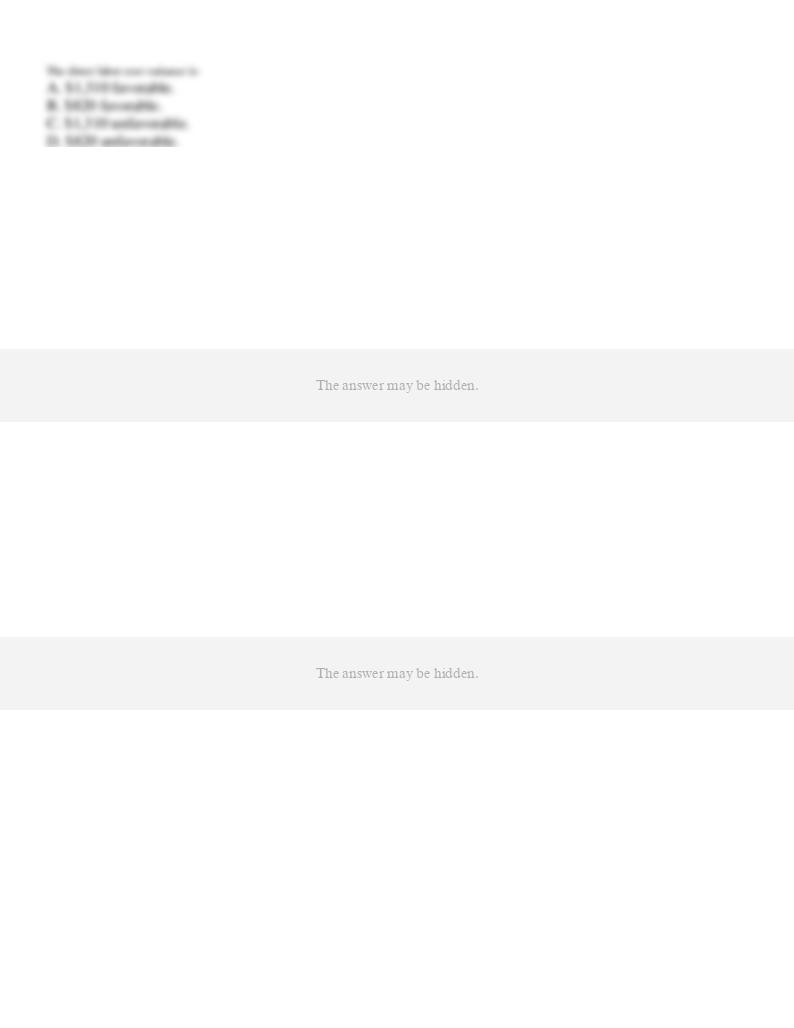
143. The standard fixed factory overhead rate is based on 100% capacity of 120,000 machine hours for
Thompson Inc. The standard costs and the actual costs of factory overhead for the production of 25,000 units
during March were as follows:
Actual: Factory overhead
$950,000
Standard: 100,000 hours at $9.00
900,000
144. The standard fixed factory overhead rate is based on 100% capacity of 50,000 direct labor hours. The
standard costs and the actual costs for factory overhead for the production of 8,000 units during the current
month were as follows:
Standard:
40,000 hours at $3
$120,000
Actual:
Factory overhead
(41,000 direct labor hours)
131,200
145. The standard factory overhead rate is $7.50 per machine hour ($6.20 for variable factory overhead and
$1.30 for fixed factory overhead) based on 100% capacity of 80,000 machine hours. The standard cost and the
actual cost of factory overhead for the production of 15,000 units during August were as follows:
Actual:
Variable factory overhead
$360,000
Fixed factory overhead
104,000
Standard:
60,000 hours at $7.50
450,000
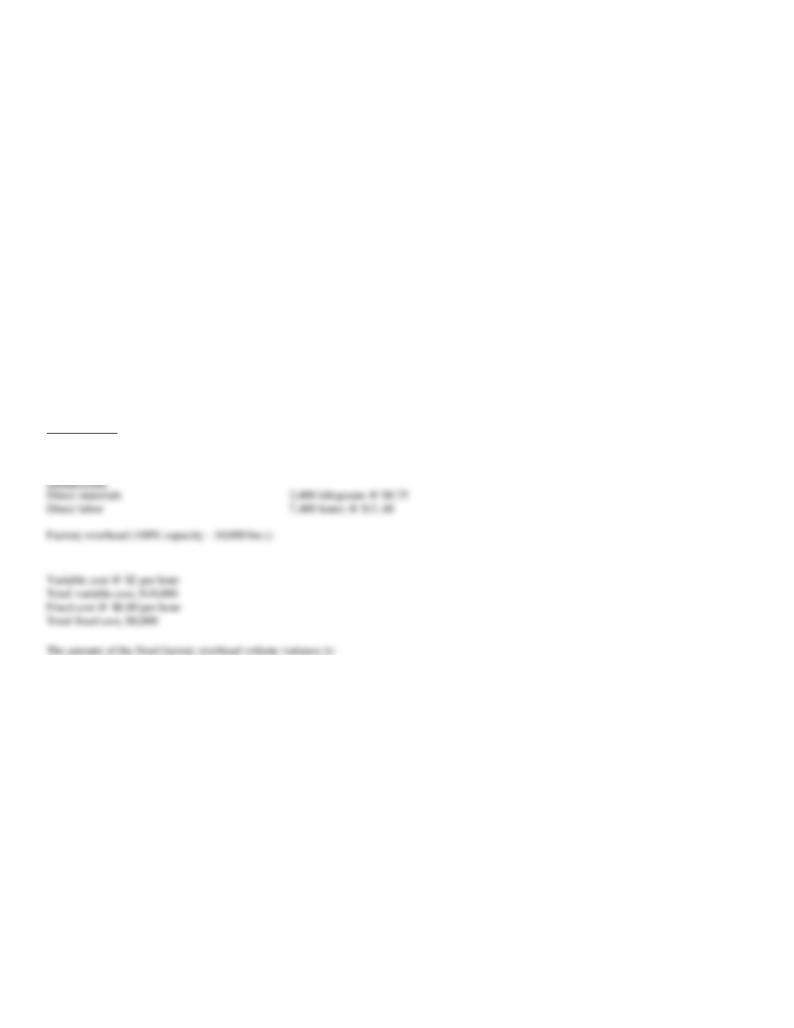
What is the amount of the fixed factory overhead volume variance?
A. $26,000 unfavorable
B. $12,000 favorable
C. $26,000 favorable
D. $12,000 unfavorable
146. It would be most appropriate to develop direct labor time standards for use in administrative activities
when the activity involves:
A. repetitive task that produces common output.
B. nonrepetitive task that produces common output.
C. top-level management.
D. task related to nonmeasurable output.
147. The standard costs and actual costs for direct materials, direct labor, and factory overhead for the
manufacture of 2,500 units of product are as follows:
Standard Costs
Direct materials
2,500 kilograms @ $8
Direct labor
7,500 hours @ $12
A. $2,000 favorable.
B. $2,500 favorable.
C. $2,500 unfavorable.
D. $2,000 unfavorable.

148. The following data is given for the Walker Company:
Standard hours allowed per completed unit
4.5
A. $65 unfavorable.
B. $65 favorable.
C. $540 unfavorable.
D. $540 favorable.
149. The standard factory overhead rate of Quaker Inc. is $10 per direct labor hour ($8 for variable factory
overhead and $2 for fixed factory overhead) based on 100% capacity of 30,000 direct labor hours. The standard
cost and the actual cost of factory overhead for the production of 5,000 units during May were as follows:
Standard:
25,000 hours at $10
$250,000
Actual:
Variable factory overhead
202,500
Fixed factory overhead
60,000
Refer to the information provided for Quaker Inc. What is the amount of the fixed factory overhead volume variance?
A. $12,500 favorable
B. $10,000 unfavorable
C. $12,500 unfavorable
D. $10,000 favorable
150. The standard factory overhead rate of Quaker Inc. is $10 per direct labor hour ($8 for variable factory
overhead and $2 for fixed factory overhead) based on 100% capacity of 30,000 direct labor hours. The standard
cost and the actual cost of factory overhead for the production of 5,000 units during May were as follows:
Standard:
25,000 hours at $10
$250,000
Actual:
Variable factory overhead
202,500
Fixed factory overhead
60,000
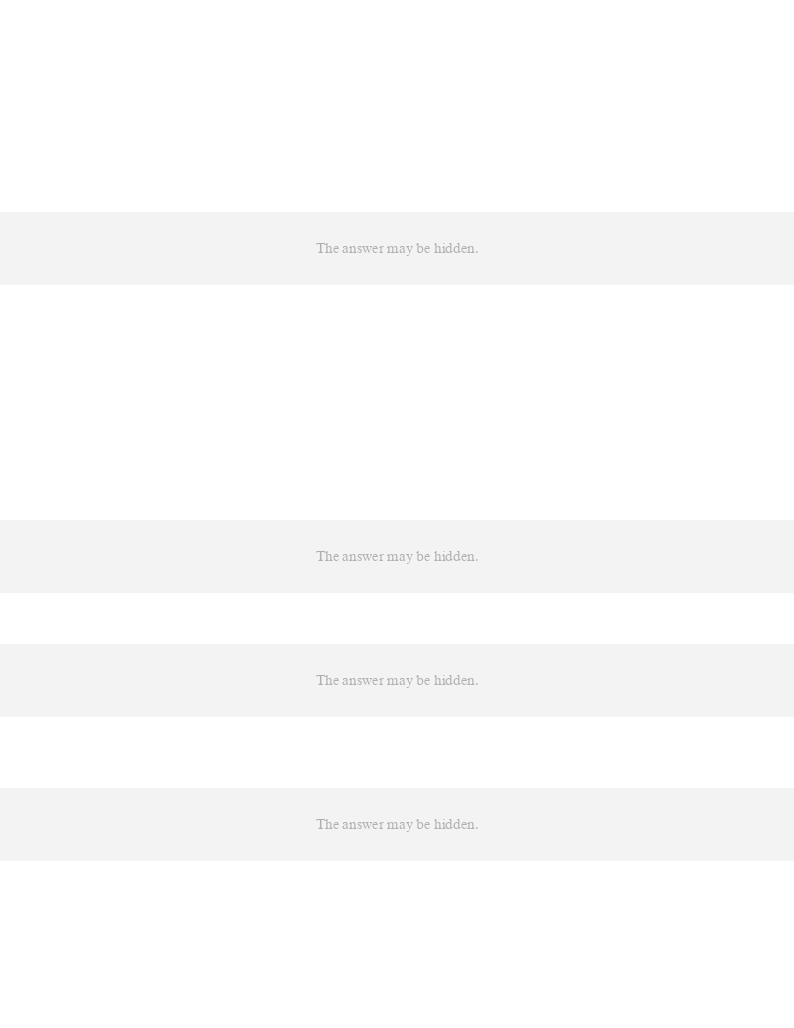
Refer to the information provided for Quaker Inc. What is the amount of the variable factory overhead controllable variance?
A. $10,000 favorable
B. $2,500 unfavorable
C. $10,000 unfavorable
D. $2,500 favorable
152. The standard factory overhead rate is $7.50 per machine hour ($6.20 for variable factory overhead and
$1.30 for fixed factory overhead) based on 100% capacity of 80,000 machine hours. The standard cost and the
actual cost of factory overhead for the production of 15,000 units during August were as follows:
Actual:
Variable factory overhead
$360,000
Fixed factory overhead
104,000
Standard:
60,000 hours at $7.50
450,000
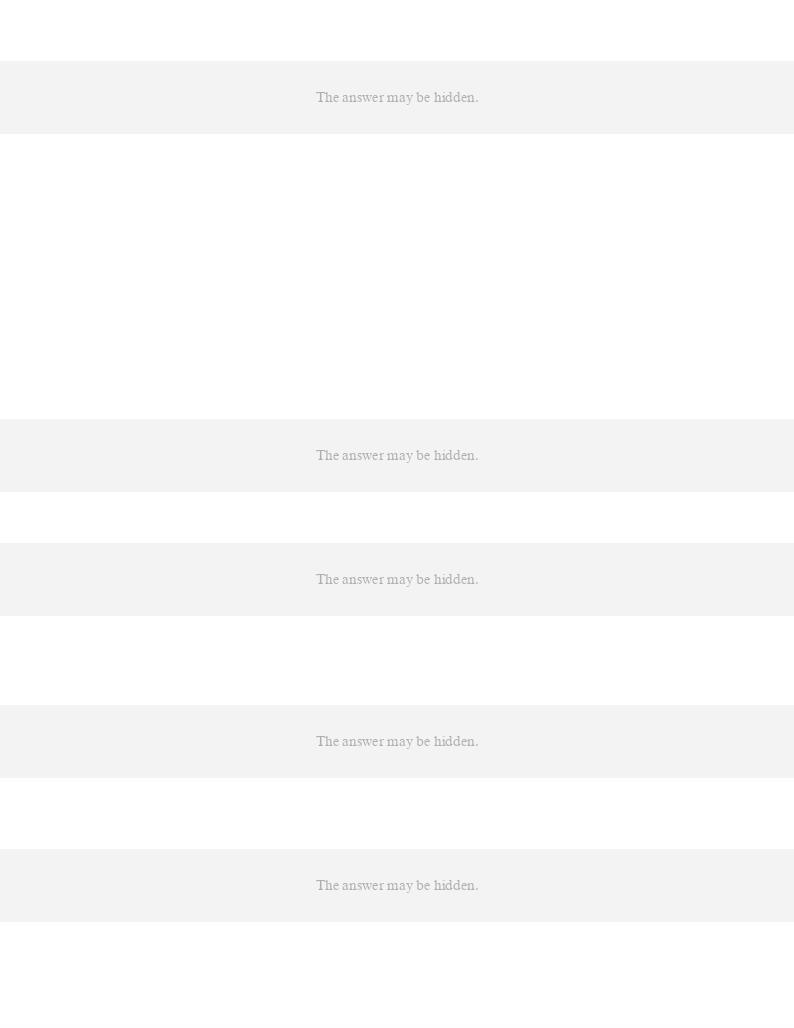
156. Standard Corporation uses a standard cost system. The following information was provided for the period
that just ended:
Standard time per completed unit
3 hrs.
Actual total factory overhead
$108,000
Fixed factory overhead
$60,000
Standard fixed factory overhead rate
$2.00 per labor hour
Standard variable factory overhead rate
$1.50 per labor hour
Normal capacity
30,000 hours
Plant operated during the period
28,000 hours
Units completed during the period
9,000
158. Assuming that the standard fixed overhead rate is based on full capacity, the cost of available but unused
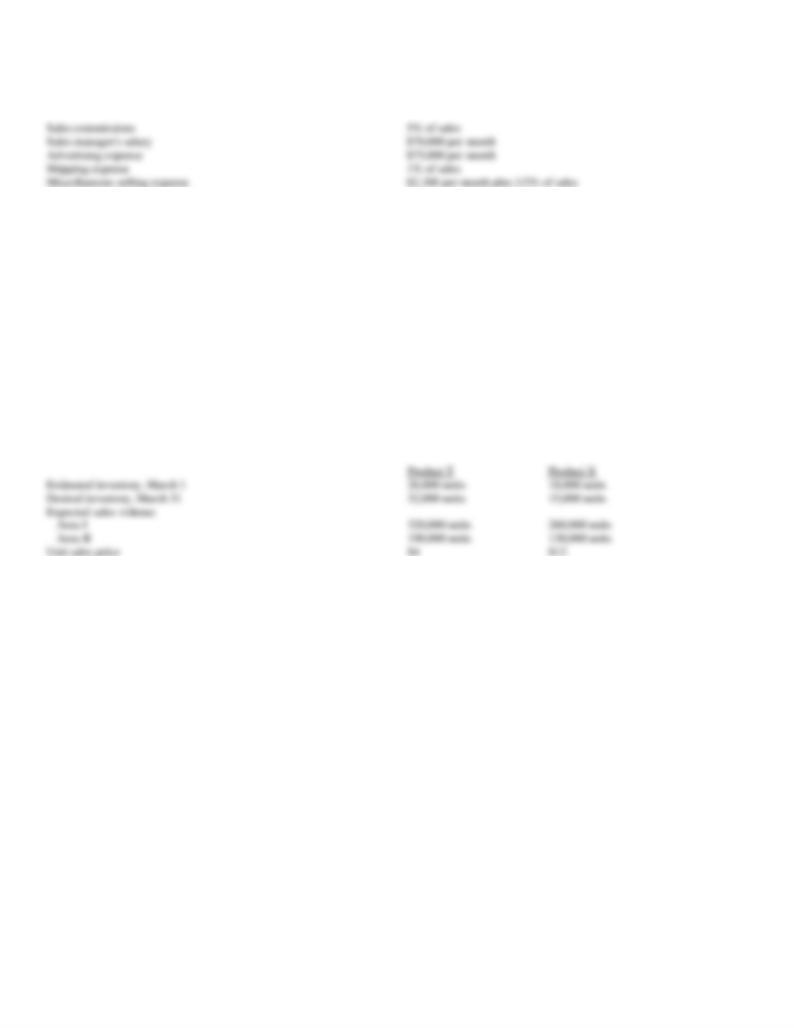
160. Prepare a monthly flexible selling expense budget for Prater Company for sales volumes of $300,000,
$400,000, and $500,000, based on the following data:
161. Based on the following production and sales data of Jackson Co. for March of the current year, prepare (a)
a sales budget and (b) a production budget.

162. Merle Company manufactures two models of Television, TV20 and TV27. Based on the following
production data for April of the current year, prepare a production budget for April.
TV20
TV27
Esti
mate
d
inve
ntory
(unit
s),
April
1
1,700
2,500
Desir
ed
2,500
2,500
163. Brown Inc.’s production budget for Product X for the year ended December 31 is as follows:
Product X
Sales
640,000 units
Plus desired ending inventory
85,000
Total
725,000
Less estimated beginning inventory, Jan. 1
90,000
Total production
635,000

164. The treasurer of Unisyms Company has accumulated the following budget information for the first two
months of the coming year:
March
April
Sales
$450,000
$520,000
Manufacturing costs
290,000
350,000
Selling and administrative expenses
41,400
46,400
Capital additions
250,000
—-
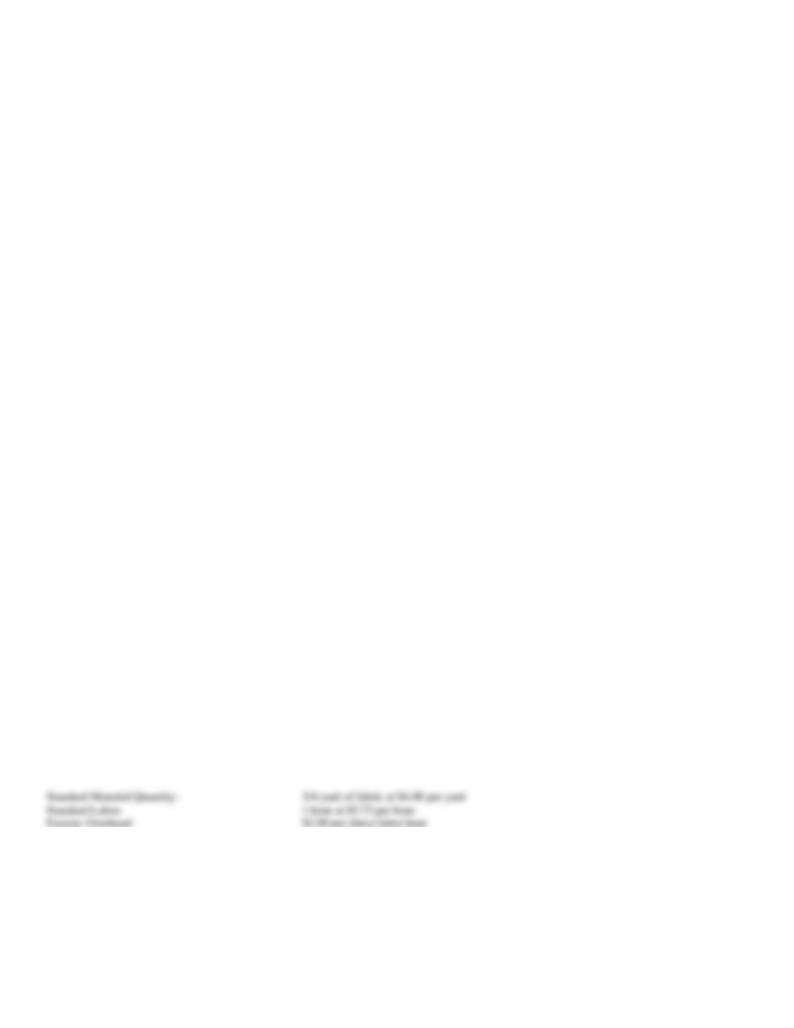
165. Trapp Co. was organized on August 1 of the current year. Projected sales for the next three months are as
follows:
August
$100,000
September
185,000
October
225,000
The company expects to sell 40% of its merchandise for cash. Of the sales on account, one third are expected to be collected in the month of the sale
and the remainder in the following month.
Prepare a schedule indicating cash collections of accounts receivable for August, September, and October.
166. Standard and actual costs for direct materials for the manufacture of 1,000 units of product were as
follows:
Actual costs
1,450 lbs. @ $8.10
Standard costs
1,500 lbs. @ $8.00
Determine the (a) quantity variance, (b) price variance, and (c) total direct materials cost variance.
167. Compute the standard cost for one hat, based on the following standards for each hat:
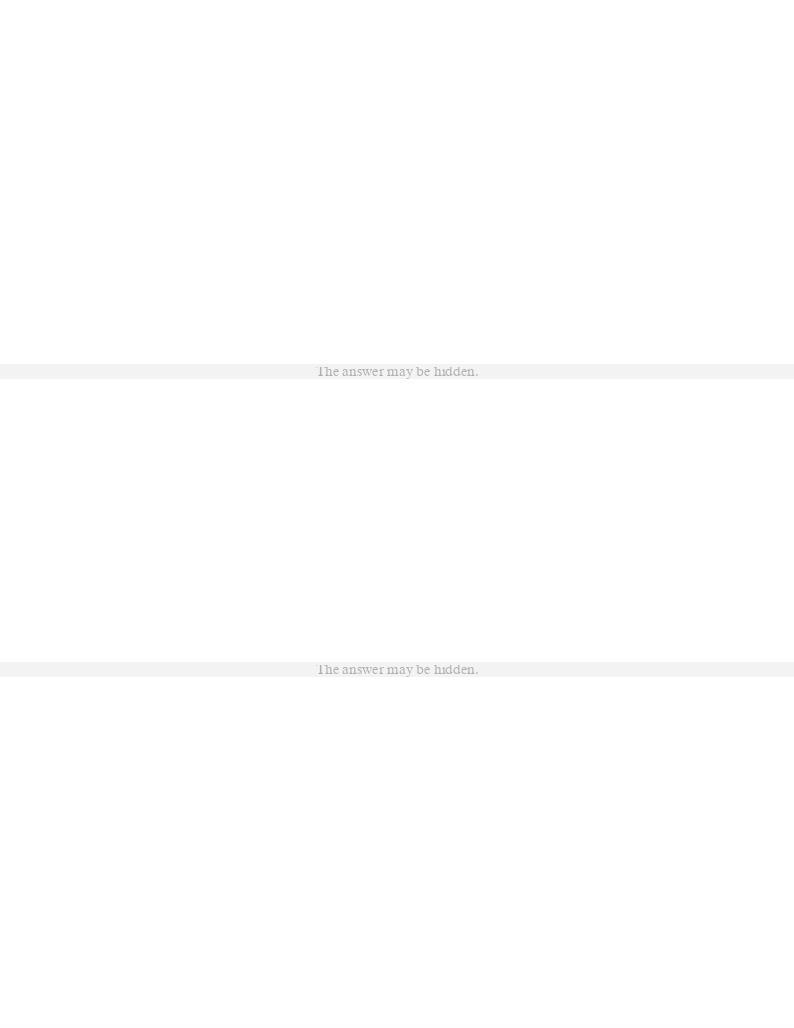
168. Standard and actual costs for direct materials for the manufacture of 1,000 units of product were as
follows:
Actual costs
1,550 lbs. @ $9.10
Standard costs
1,600 lbs. @ $9.00
169. Standard and actual costs for direct labor for the manufacture of 1,000 units of product were as follows:
Actual costs
480 hours @ $18.00
Standard costs
485 hours @ $17.50

170. The standard factory overhead rate is $12 per machine hour ($10 for variable factory overhead and $2 for
fixed factory overhead) based on 100% capacity of 42,000 machine hours. The standard cost and the actual cost
of factory overhead for the production of 2,000 units were as follows:
Actual: Variable factory overhead
$350,500
Fixed factory overhead
84,000
Standard: 35,000 hours @ $12
420,000
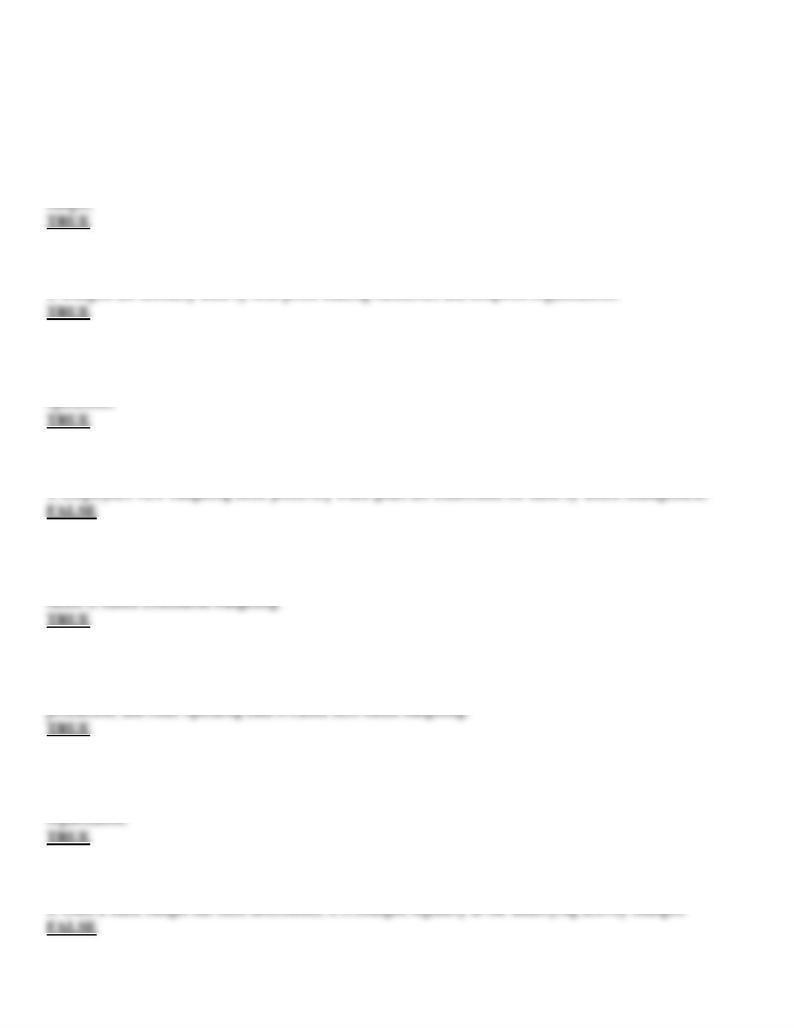
Chapter 13--Budgeting and Standard Cost Systems Key
1. A formal written statement of management's plans for the future, expressed in financial terms, is called a
3. When budget goals are set too tight, the budget becomes less effective for planning and controlling
5. A budget procedure that provides for the maintenance at all times of a twelve-month projection into the
6. The budget procedure that requires all levels of management to start from zero in estimating sales,
7. Goal conflict can be avoided if budget goals are carefully designed for consistency across all areas of the
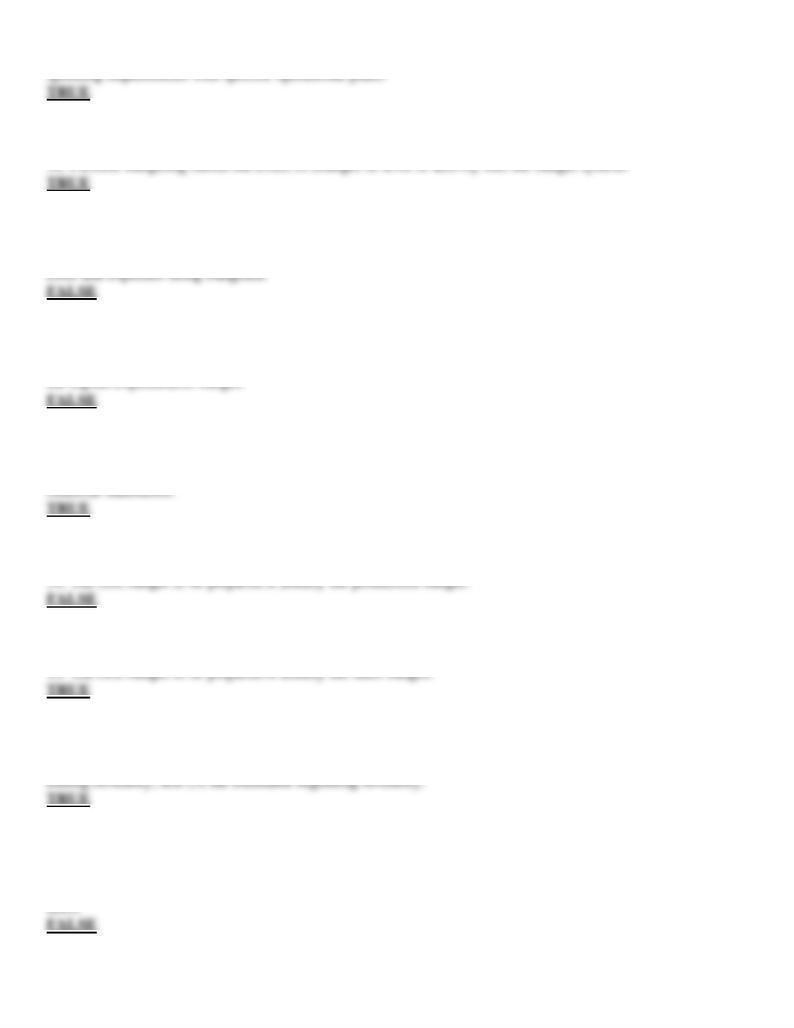
9. Budgetary slack can be avoided if lower and mid-level managers are requested to support all of their
11. In preparing flexible budgets, the first step is to identify the fixed and variable components of the various
12. The master budget of a small manufacturer would normally include all necessary component budgets except
13. The master budget of a small manufacturer would normally include all component budgets that impact the
16. The budgeted volume of production is based on the sum of (1) the expected sales volume and (2) the desired
17. If Division Inc. expects to sell 200,000 units in 2012, desires ending inventory of 24,000 units, and has
22,000 units on hand as of the beginning of the year, the budgeted volume of production for 2012 is 198,000
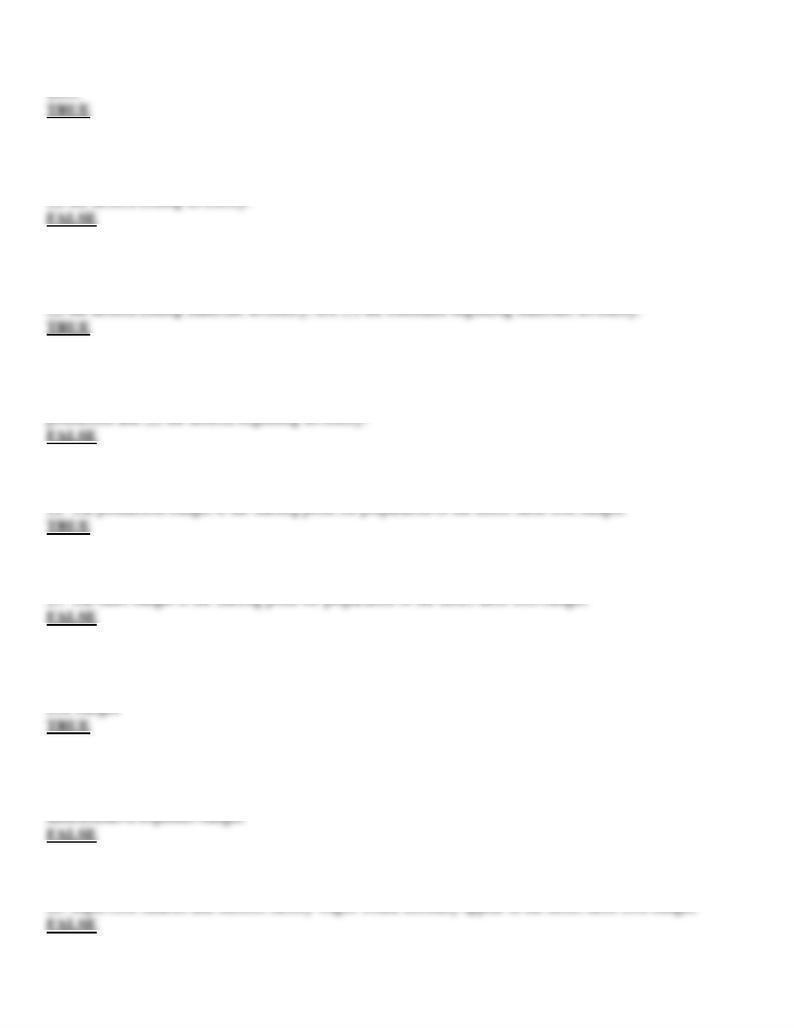
18. If Division Inc. expects to sell 300,000 units in 2012, desires ending inventory of 22,000 units, and has
24,000 units on hand as of the beginning of the year, the budgeted volume of production for 2012 is 298,000
19. The budgeted volume of production is normally computed as the sum of (1) the expected sales volume and
20. The budgeted direct materials purchases are based on the sum of (1) the materials needed for production and
21. The budgeted direct materials purchases are normally computed as the sum of (1) the materials for
24. Supervisor salaries, maintenance, and indirect factory wages would normally appear in the factory overhead
25. Supervisor salaries, maintenance, and indirect factory wages would normally appear in the selling and
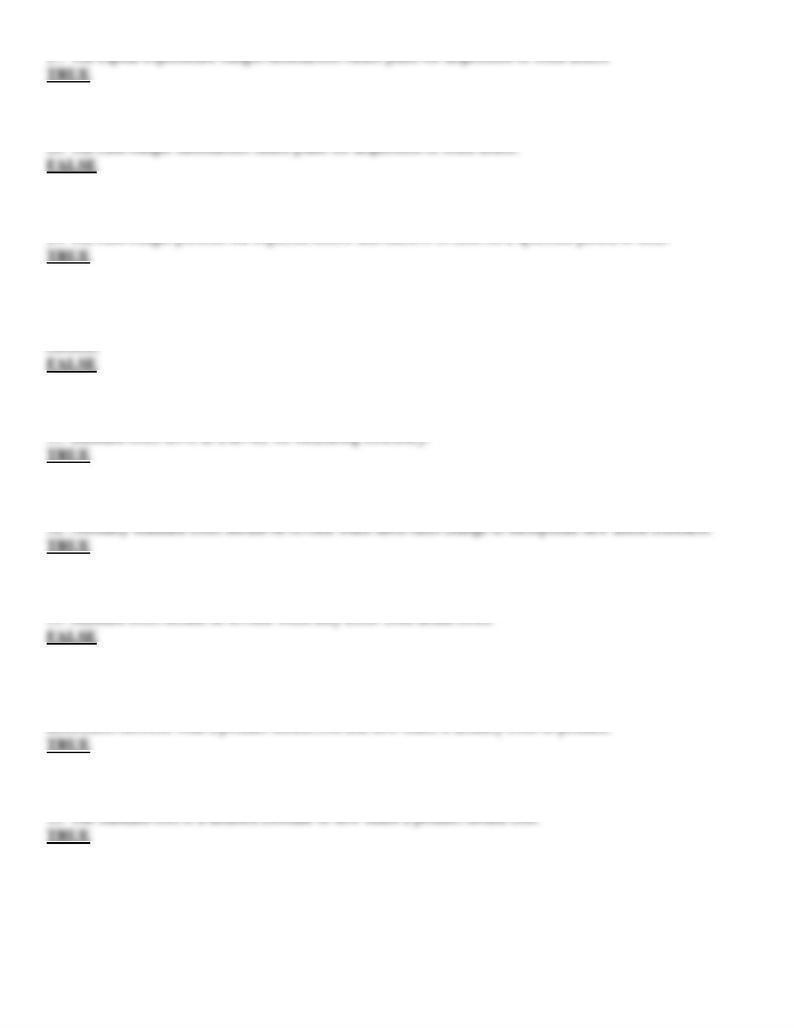
30. A variable cost system is an accounting system where standards are set for each manufacturing cost
34. As a device for measuring efficiency, standard cost systems enables management to determine the causes of
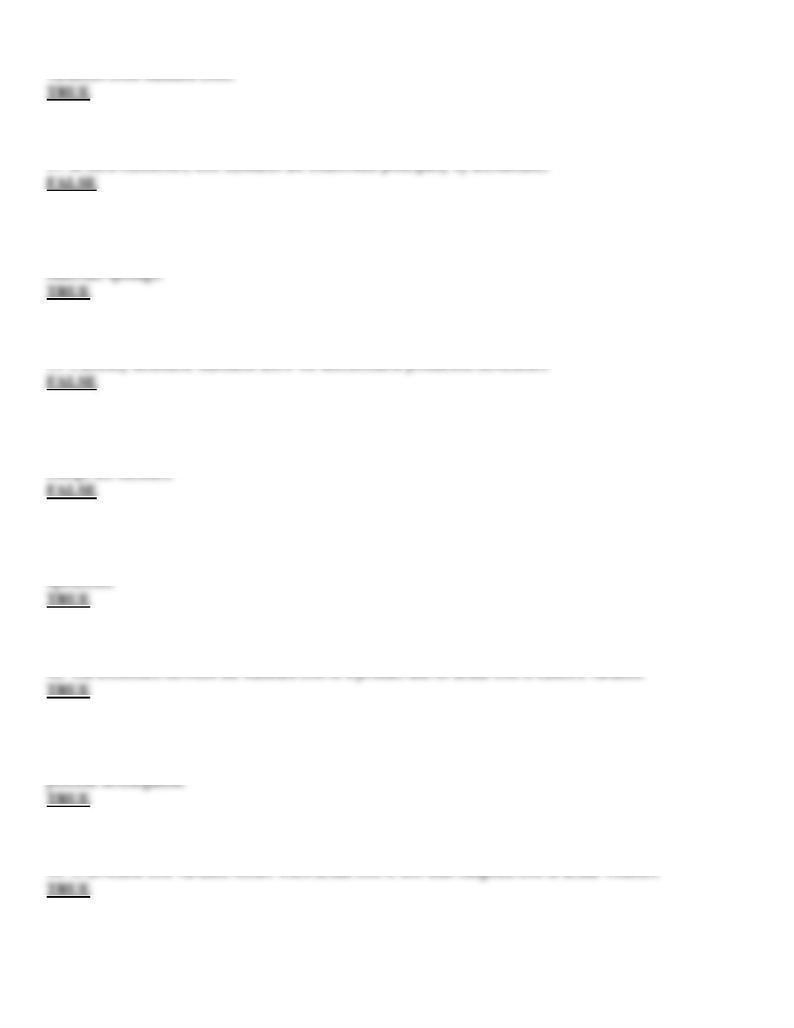
36. Financial reporting systems that are guided by the principle of exceptions concept focus attention on
38. Ideal standards are developed under conditions that assume no idle time, no machine breakdowns, and no
40. The fact that workers are unable to meet a properly determined direct labor standard is sufficient cause to
41. Changes in technology, machinery, or production methods may make past cost data irrelevant for future
43. A budget performance report compares actual results with the budgeted amounts and reports differences for
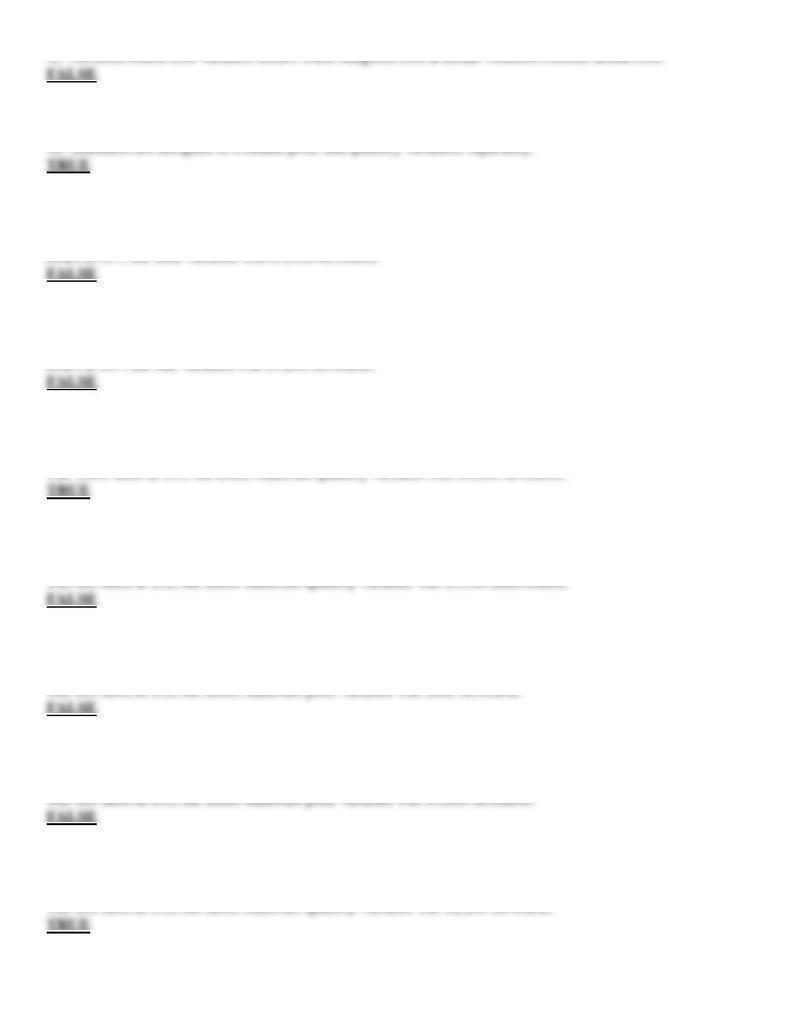
47. If the standard to produce a given amount of product is 500 direct labor hours at $15 and the actual was 600
48. If the standard to produce a given amount of product is 500 direct labor hours at $15 and the actual was 600
49. If the standard to produce a given amount of product is 2,000 units of direct materials at $12 and the actual
50. If the standard to produce a given amount of product is 900 units of direct materials at $11 and the actual
51. If the standard to produce a given amount of product is 1,000 units of direct materials at $11 and the actual
52. If the standard to produce a given amount of product is 1,000 units of direct materials at $11 and the actual
53. If the standard to produce a given amount of product is 1,000 units of direct materials at $11 and the actual
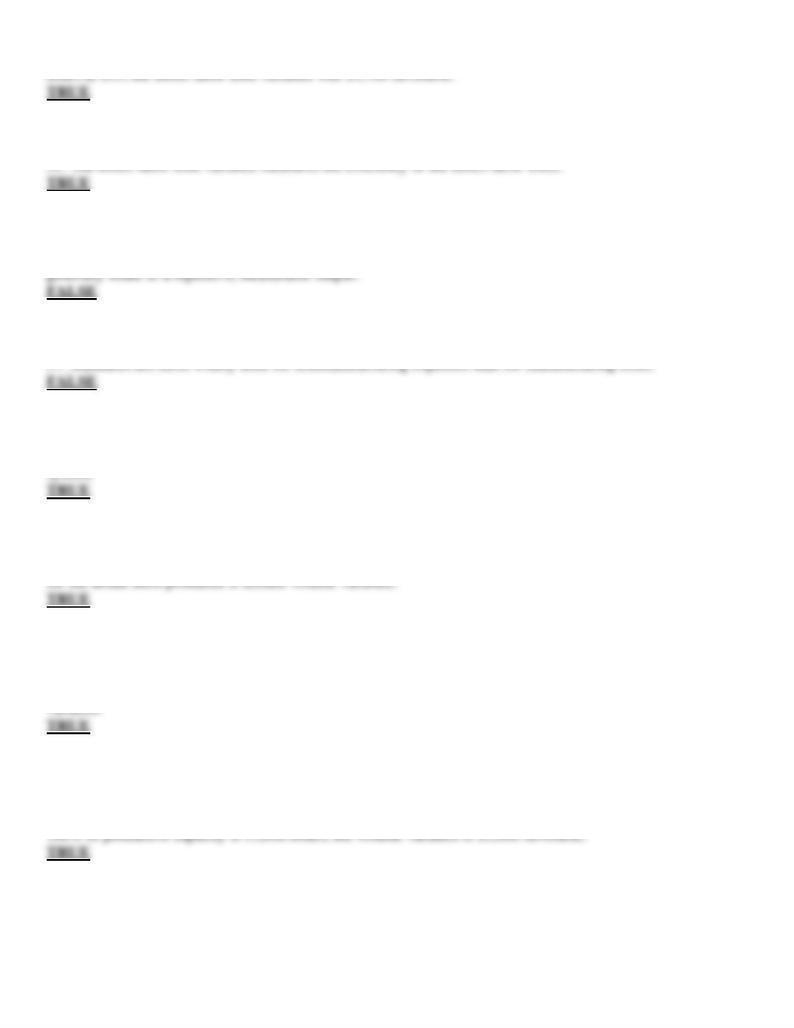
54. If the standard to produce a given amount of product is 600 direct labor hours at $17 and the actual was 500
56. Using a standard costing system for nonmanufacturing expenses is easily administered because the expenses
58. Nonmanufacturing activities are usually controlled using a static budget rather than a standard costing
59. The difference between the budgeted fixed overhead at 100% of normal capacity and the standard fixed cost
60. The difference between the actual amount of variable factory overhead cost incurred and the amount of
variable factory overhead budgeted for the standard product is termed as variable factory overhead controllable
61. If the standard to produce certain quantity of product is 16,000 hours at a factory overhead rate of $5 ($3
fixed, $2 variable), actual variable factory overhead is $26,400, actual fixed factory overhead is $45,000, and
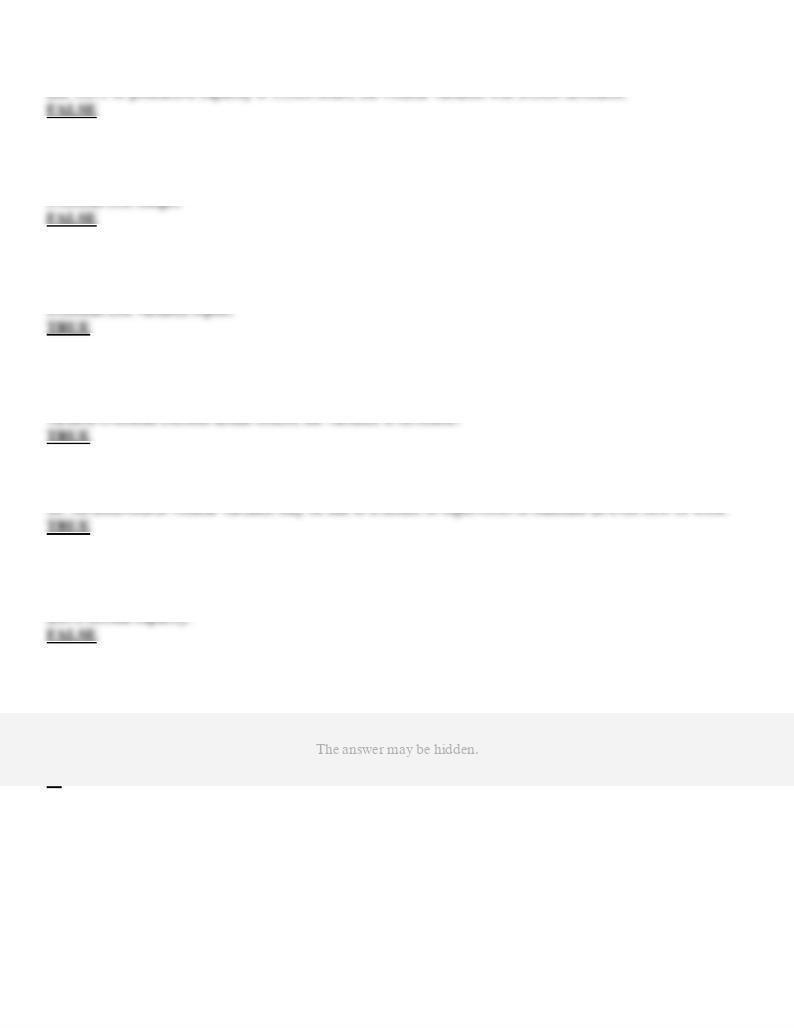
62. If the standard to produce a given amount of product is 12,000 hours at a factory overhead rate of $5 ($3
fixed, $2 variable), actual variable factory overhead was $26,400, actual fixed factory overhead was $45,000,
63. The most effective means of presenting standard factory overhead cost variance data is through a selling
64. The most effective means of presenting standard factory overhead cost variance data is through a factory
65. Since the controllable variance measures the efficiency of using variable overhead resources, if budgeted
67. Favorable volume variances are never harmful since achieving them encourages managers to run the factory
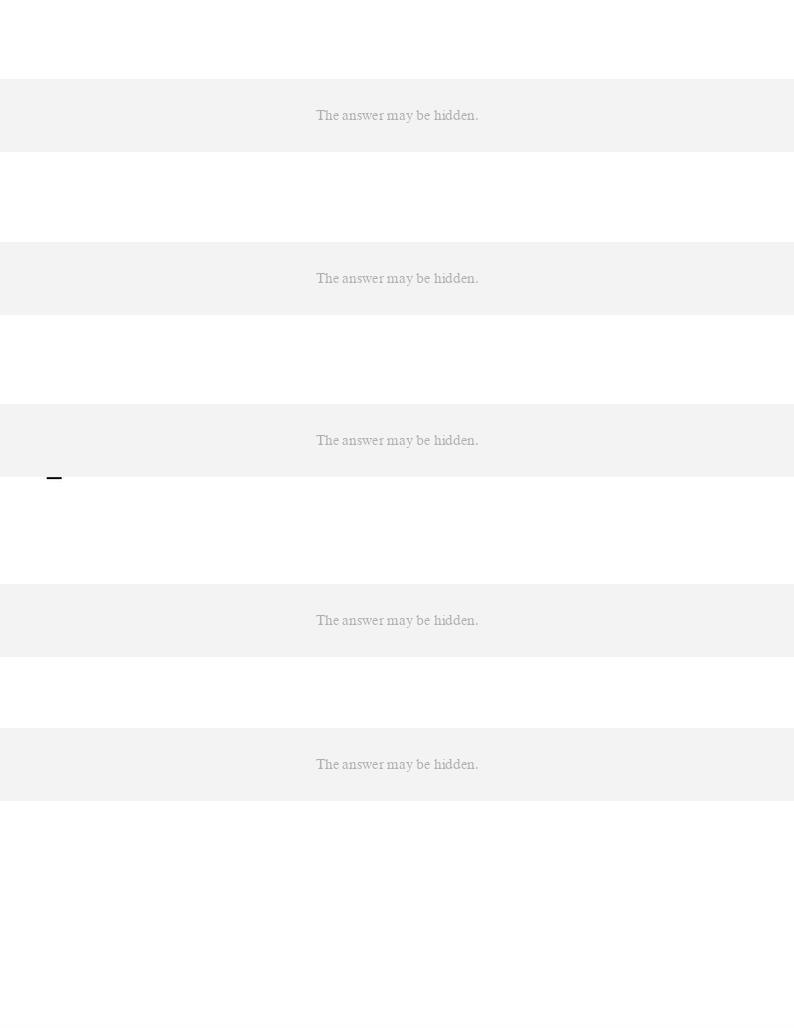
69. Department managers plan lower goals than possible in order to build in a cushion for unexpected events.
70. The process of developing budget estimates by requiring all levels of management to estimate sales,
71. A variant of fiscal-year budgeting whereby a twelve-month projection into the future is maintained at all
72. Christiansen and Sons' static budget for 10,000 units of production includes $50,000 for direct materials,
$44,000 for direct labor, utilities of $5,000, and supervisor salaries of $15,000. A flexible budget for 12,000
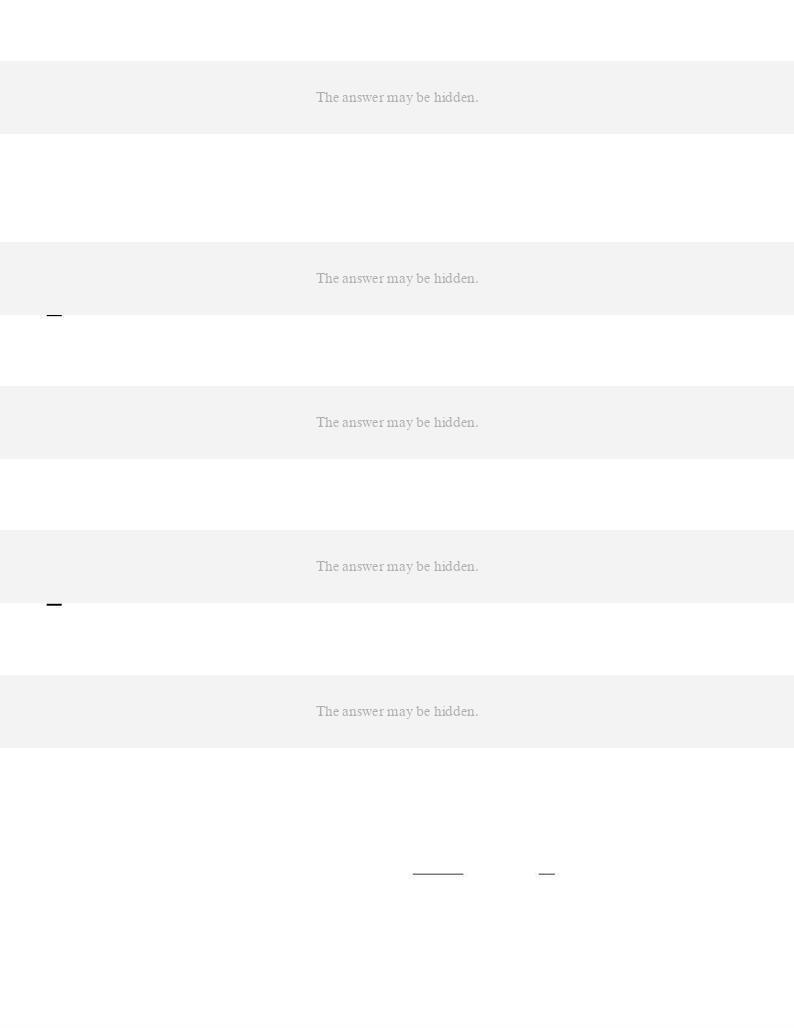
75. For February, sales revenue is $250,000; sales commissions are 6% of sales; the sales manager's salary is
$50,000; advertising expenses are $15,000; shipping expenses total 1% of sales; and miscellaneous selling
79. Below is budgeted production and sales information for Cooper Cans, Inc. for the month of March:
Aluminum
Tin
Estimated beginning inventory
10,000 units
4,000 units
Desired ending inventory
14,000 units
3,000 units
Region I, anticipated sales
360,000 units
80,000 units
Region II, anticipated sales
120,000 units
20,000 units
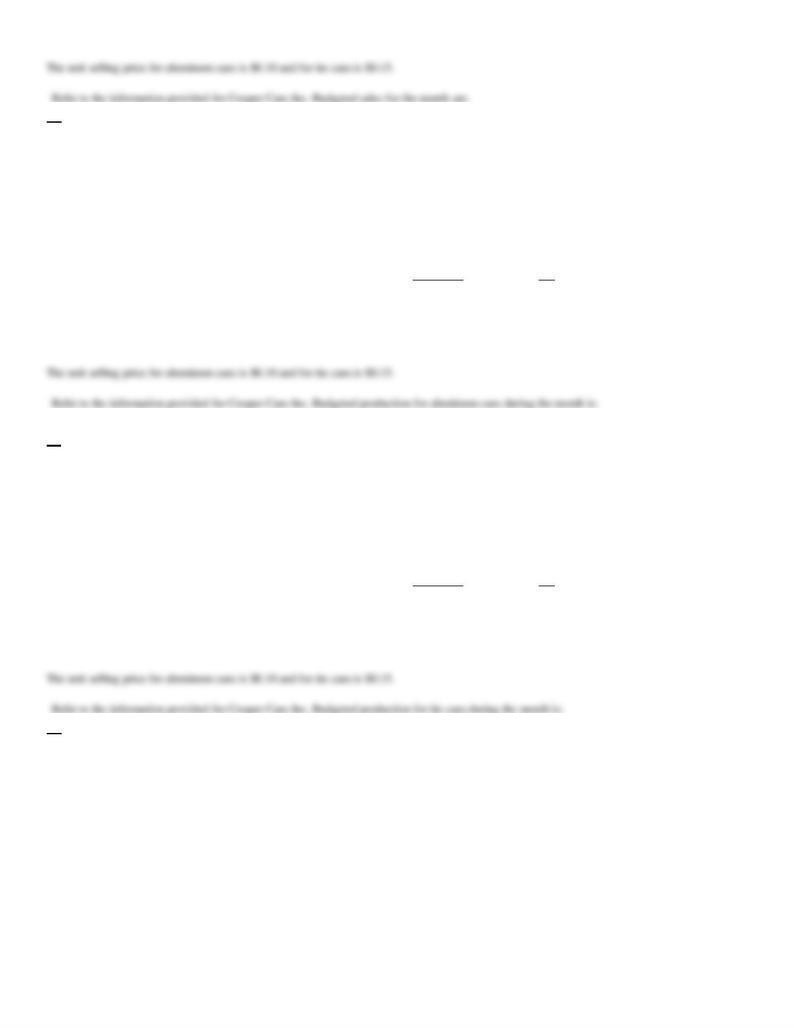
A. $63,000.
B. $62,750.
C. $63,250.
D. $66,450.
80. Below is budgeted production and sales information for Cooper Cans, Inc. for the month of March:
Aluminum
Tin
Estimated beginning inventory
10,000 units
4,000 units
Desired ending inventory
14,000 units
3,000 units
Region I, anticipated sales
360,000 units
80,000 units
Region II, anticipated sales
120,000 units
20,000 units
A. 476,000 units.
B. 484,000 units.
C. 480,000 units.
D. 504,000 units.
81. Below is budgeted production and sales information for Cooper Cans, Inc. for the month of March:
Aluminum
Tin
Estimated beginning inventory
10,000 units
4,000 units
Desired ending inventory
14,000 units
3,000 units
Region I, anticipated sales
360,000 units
80,000 units
Region II, anticipated sales
120,000 units
20,000 units
A. 99,000 units.
B. 101,000 units.
C. 100,000 units.
D. 107,000 units.
82. Cape Corporation sells a single product. Budgeted sales for the year are anticipated to be 640,000 units,
estimated beginning inventory is 98,000 units, and desired ending inventory is 80,000 units. The quantities of
direct materials expected to be used for each unit of finished product are given below.
Material A
.50 lb. per unit
@ $0.60 per pound
Material B
1.00 lb. per unit
@ $1.70 per pound
Material C
1.20 lb. per unit
@ $1.00 per pound
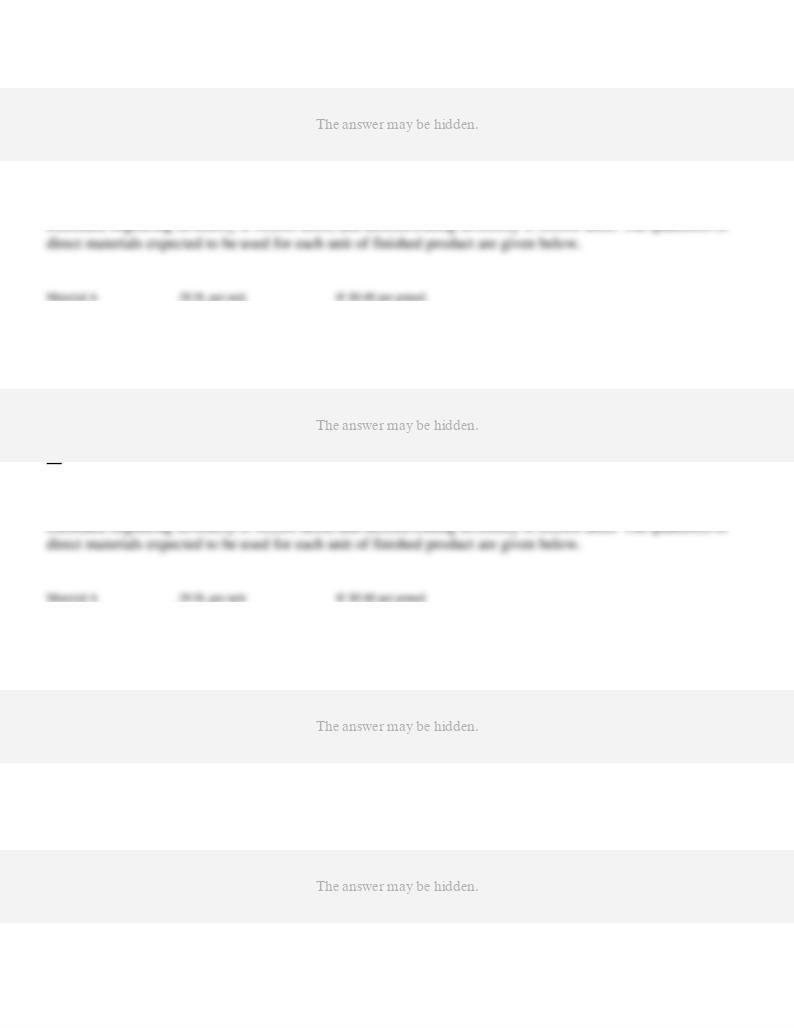
83. Cape Corporation sells a single product. Budgeted sales for the year are anticipated to be 640,000 units,
Material B
1.00 lb. per unit
@ $1.70 per pound
Material C
1.20 lb. per unit
@ $1.00 per pound
84. Cape Corporation sells a single product. Budgeted sales for the year are anticipated to be 640,000 units,
Material B
1.00 lb. per unit
@ $1.70 per pound
Material C
1.20 lb. per unit
@ $1.00 per pound
85. If the expected sales volume for the current period is 22,000 units, the desired ending inventory is 800 units,
and the beginning inventory is 500 units, the number of units set forth in the production budget, representing

86. Production estimates for August are as follows:
Estimated inventory (units), August 1
3,000
Desired inventory (units), August 31
2,000
Expected sales volume (units), August
40,000
A. 195,000 lbs. of A; 39,000 lbs. of B.
B. 200,000 lbs. of A; 40,000 lbs. of B.
C. 205,000 lbs. of A; 41,000 lbs. of B.
D. 210,000 lbs. of A; 42,000 lbs. of B.
87. Production estimates for August are as follows:
Estimated inventory (units), August 1
12,000
Desired inventory (units), August 31
9,000
Expected sales volume (units), August
75,000
A. $1,260,000 for A; $630,000 for B.
B. $1,080,000 for A; $540,000 for B.
C. $1,125,000 for A; $562,500 for B.
D. $1,170,000 for A; $585,000 for B.
88. Production estimates for July are as follows:
Estimated inventory (units), July 1
650
Desired inventory (units), July 31
1,050
Expected sales volume (units), July
7,600
A. 24,000.
B. 21,600.
C. 22,800.
D. 25,950.
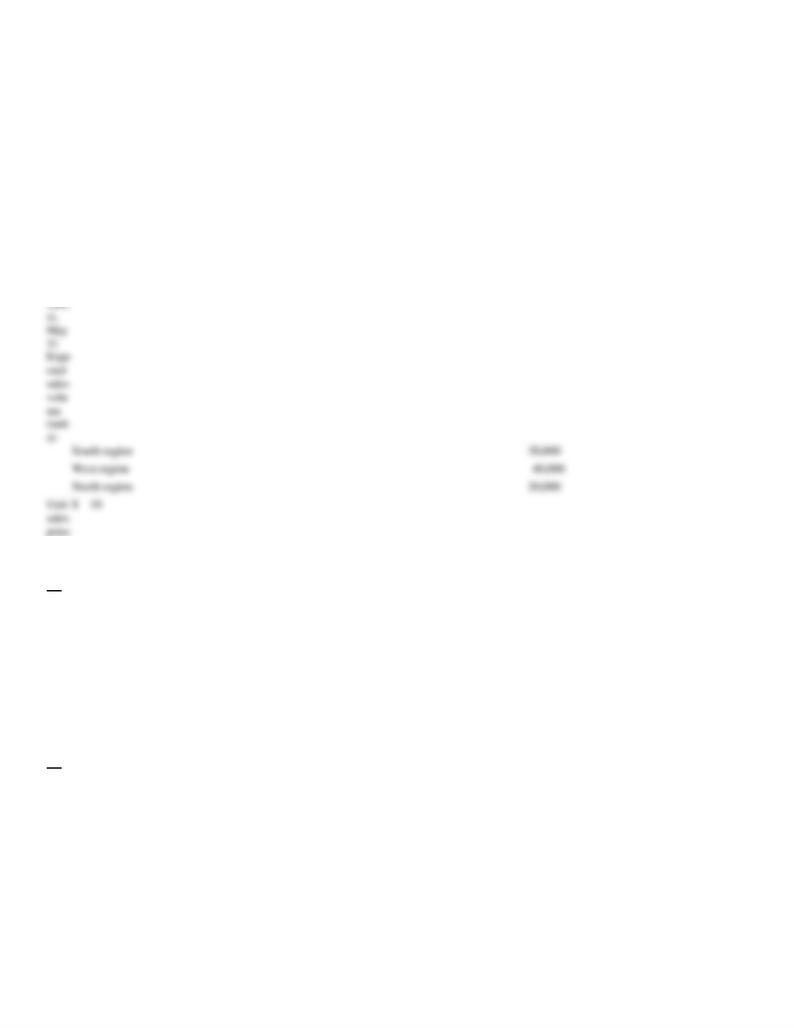
89. Based on the following production and sales estimates for May, determine the number of units expected to
be manufactured in May.
Esti
mate
d
inve
ntory
(unit
s),
May
1
20,000
Desir
ed
inve
ntory
15,000
A. 85,000 units
B. 90,000 units
C. 95,000 units
D. 105,000 units
90. Which of the following budgets provides the starting point for the preparation of the direct labor cost
budget?
A. Direct materials purchases budget
B. Cash budget
C. Production budget
D. Factory overhead budget
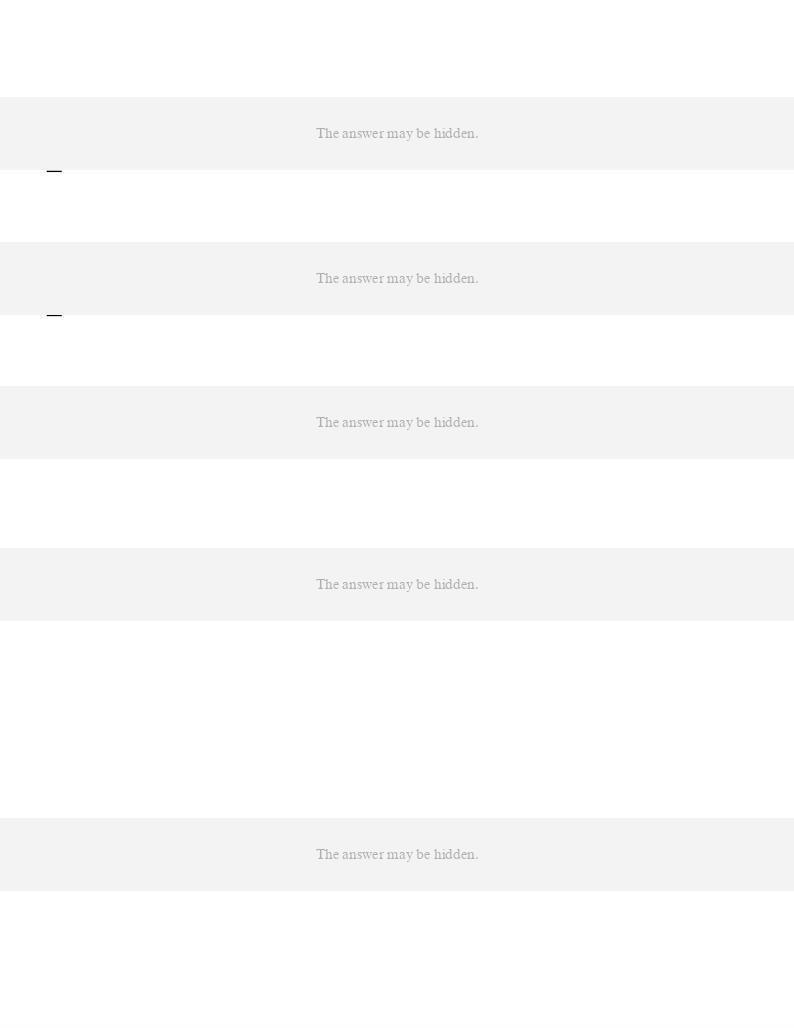
91. If the expected sales volume for the current period is 7,000 units, the desired ending inventory is 400 units,
and the beginning inventory is 300 units, the number of units set forth in the production budget, representing
94. For which of the following reasons, management accountants usually provide for a minimum cash balance
95. Benjamin Corporation began its operations on September 1 of the current year. Budgeted sales for the first
three months of business are $250,000, $300,000, and $420,000, respectively, for September, October, and
November. The company expects to sell 20% of its merchandise for cash. Of sales on account, 70% are
expected to be collected in the month of the sale, 25% in the month following the sale, and the remainder in the
following month.
Refer to the information provided for Benjamin Corporation. The cash collections from accounts receivable in
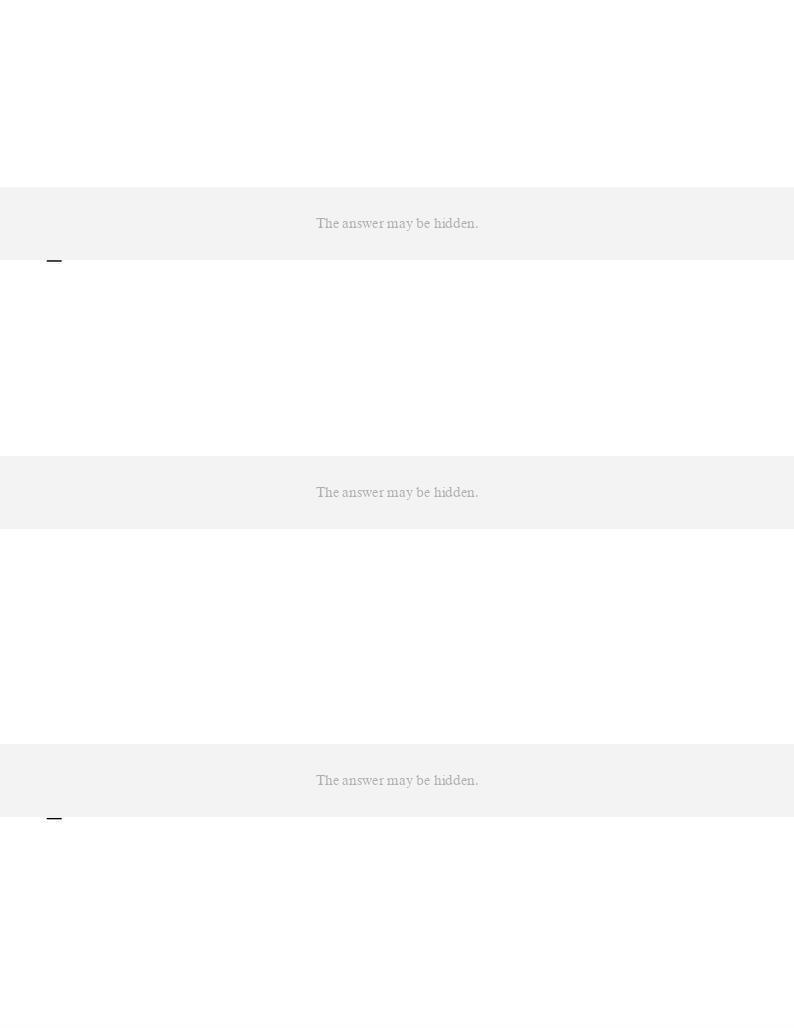
96. Benjamin Corporation began its operations on September 1 of the current year. Budgeted sales for the first
three months of business are $250,000, $300,000, and $420,000, respectively, for September, October, and
November. The company expects to sell 20% of its merchandise for cash. Of sales on account, 70% are
expected to be collected in the month of the sale, 25% in the month following the sale, and the remainder in the
following month.
Refer to the information provided for Benjamin Corporation. The cash collections from accounts receivable in
97. Benjamin Corporation began its operations on September 1 of the current year. Budgeted sales for the first
three months of business are $250,000, $300,000, and $420,000, respectively, for September, October, and
November. The company expects to sell 20% of its merchandise for cash. Of sales on account, 70% are
expected to be collected in the month of the sale, 25% in the month following the sale, and the remainder in the
following month.
Refer to the information provided for Benjamin Corporation. The cash collections from accounts receivable in
98. Kohlman Company began its operations on March 31 of the current year. Projected manufacturing costs for
the first three months of business are $156,800, $195,200, and $217,600, respectively, for April, May, and June.
Depreciation, insurance, and property taxes represent $28,800 of the estimated monthly manufacturing costs.
Insurance was paid on March 31, and property taxes will be paid in November. Three-fourths of the remainder
of the manufacturing costs are expected to be paid in the month in which they are incurred with the balance to
be paid in the following month.
Refer to the information provided for Kohlman Company. The cash payments for manufacturing in the month

99. Kohlman Company began its operations on March 31 of the current year. Projected manufacturing costs for
the first three months of business are $156,800, $195,200, and $217,600, respectively, for April, May, and June.
Depreciation, insurance, and property taxes represent $28,800 of the estimated monthly manufacturing costs.
Insurance was paid on March 31, and property taxes will be paid in November. Three-fourths of the remainder
of the manufacturing costs are expected to be paid in the month in which they are incurred with the balance to
be paid in the following month.
Refer to the information provided for Kohlman Company. The cash payments for manufacturing in the month
100. Kohlman Company began its operations on March 31 of the current year. Projected manufacturing costs
for the first three months of business are $156,800, $195,200, and $217,600, respectively, for April, May, and
June. Depreciation, insurance, and property taxes represent $28,800 of the estimated monthly manufacturing
costs. Insurance was paid on March 31, and property taxes will be paid in November. Three-fourths of the
remainder of the manufacturing costs are expected to be paid in the month in which they are incurred with the
balance to be paid in the following month.
Refer to the information provided for Kohlman Company. The cash payments for manufacturing in the month
101. McCabe Manufacturing Co.'s static budget at 8,000 units of production includes $40,000 for direct labor
and $4,000 for electric power. Total fixed costs are $23,000. At 9,000 units of production, a flexible budget
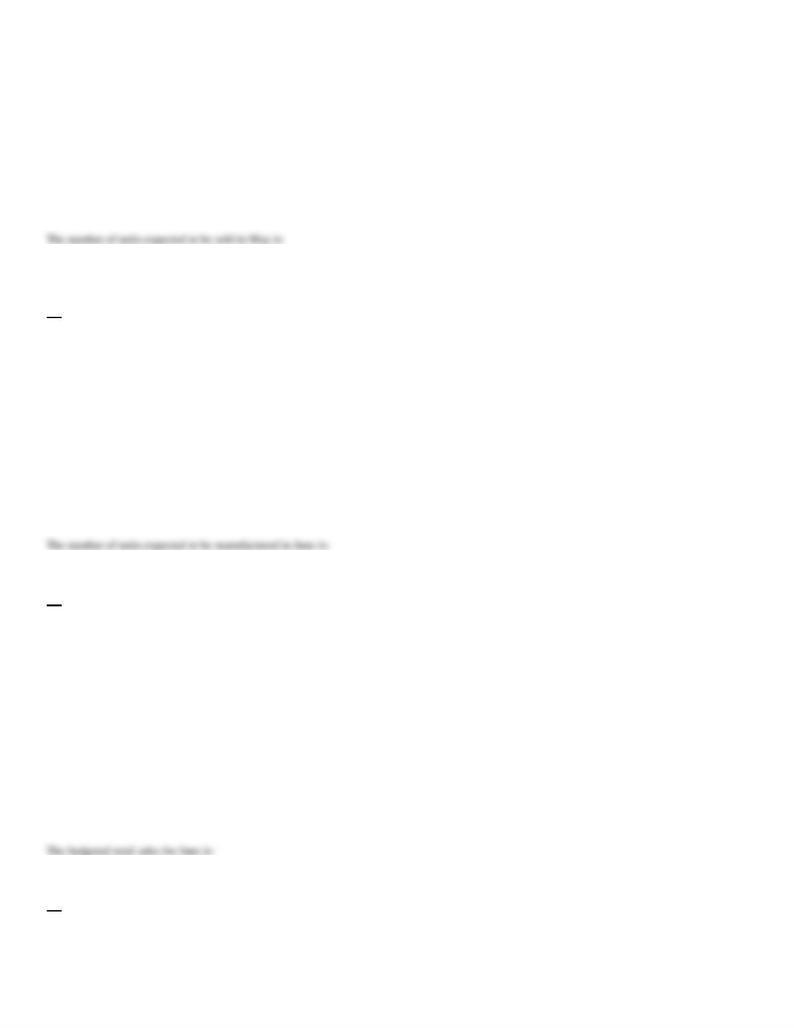
103. Production and sales estimates for May for the Hudson Co. are as follows:
Estimated inventory (units), May 1
17,500
Desired inventory (unit), May 31
19,300
Expected sales volume (units):
Area W
4,200
Area X
7,000
Area Y
9,000
Unit sales price
$15
A. 22,000.
B. 18,400.
C. 23,800.
D. 20,200.
104. Production and sales estimates for June are as follows:
Estimated inventory (units), June 1
18,500
Desired inventory (units), June 30
19,000
Expected sales volume (units):
Area X
3,000
Area Y
4,000
Area Z
5,500
Unit sales price
$20
A. 10,000.
B. 12,000.
C. 13,000.
D. 12,500.
105. Production and sales estimates for June are as follows:
Estimated inventory (units), June 1
8,000
Desired inventory (units), June 30
9,000
Expected sales volume (units):
Area X
3,000
Area Y
4,000
Area Z
5,500
Unit sales price
$25
A. $300,000.
B. $337,500.
C. $312,500.
D. $287,500.
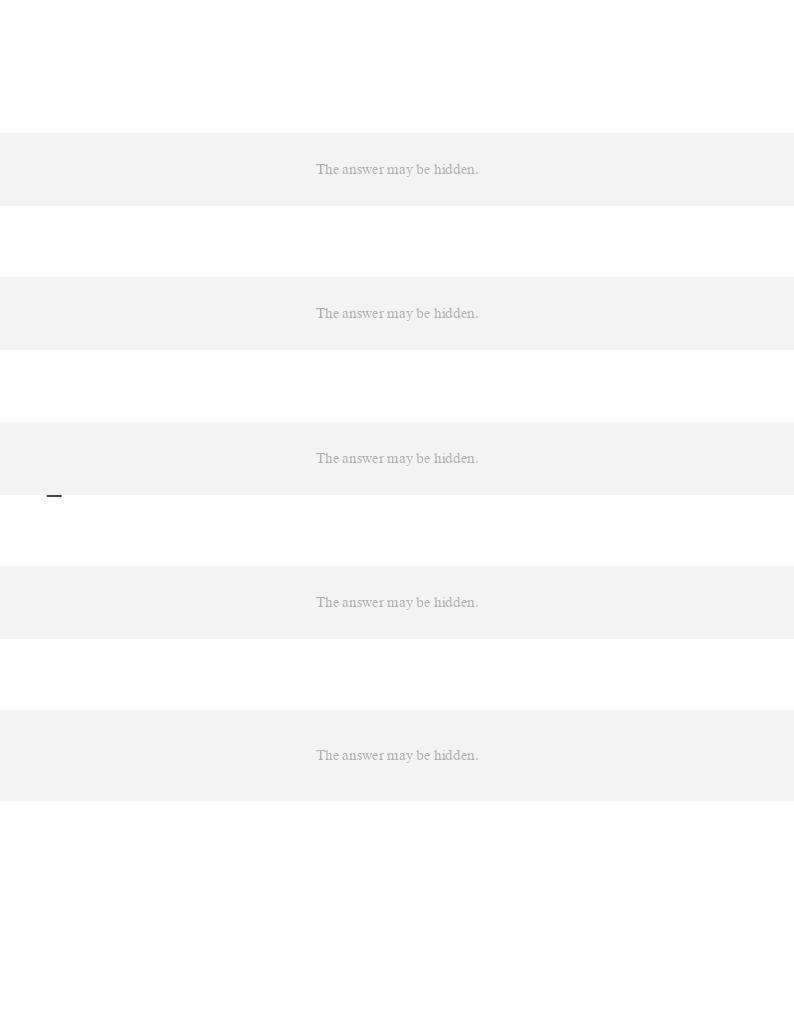
106. As of January 1 of the current year, the Butner Company had accounts receivables of $50,000. Sales for
January, February, and March were as follows: $120,000, $140,000, and $150,000. 20% of each month’s sales
are for cash. Of the remaining 80% (the credit sales), 60% are collected in the month of sale, with the remaining
40% collected in the following month. What is the total cash collected (both from accounts receivable and for

111. Following is the information about Standard Inc.
The standard costs and actual costs for direct materials, direct labor, and factory overhead for the manufacture
of 2,500 units of product are as follows:
Standard Costs
Direct materials
2,500 kilograms @ $8
Direct labor
7,500 hours @ $12
Actual Costs
A. $875 favorable.
B. $875 unfavorable.
C. $800 favorable.
D. $800 unfavorable.
112. The following data relate to direct materials costs of Texas Inc. for November:
Actual costs
4,500 pounds at $6.00
Standard costs
4,600 pounds at $5.50
Refer to the information provided for Texas Inc. What is the direct materials price variance?
A. $2,250 unfavorable
B. $2,250 favorable
C. $2,300 unfavorable
D. $1,700 unfavorable
113. The following data relate to direct materials costs of Texas Inc. for November:
Actual costs
4,500 pounds at $6.00
Standard costs
4,600 pounds at $5.50
Refer to the information provided for Texas Inc. What is the direct materials quantity variance?
A. $550 unfavorable
B. $550 favorable
C. $600 favorable
D. $600 unfavorable
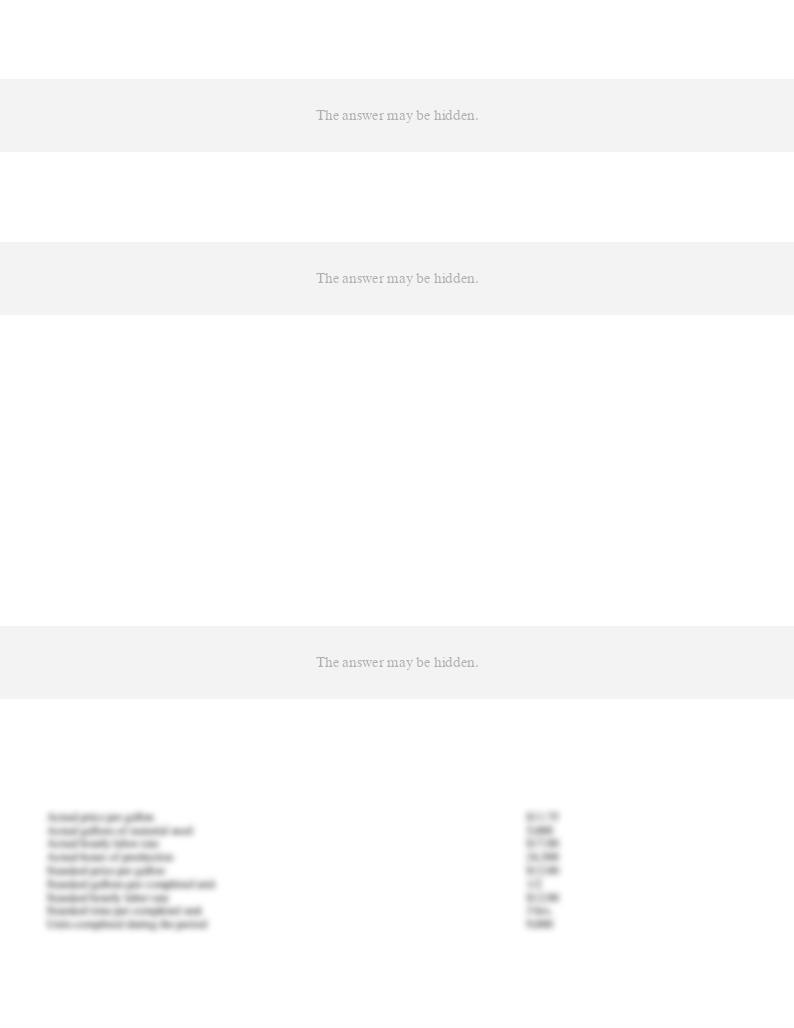
114. If the actual quantity of direct materials used in producing a commodity differs from the standard quantity,
115. If the price paid per unit differs from the standard price per unit for direct materials, the variance is
116. Efficient Corporation uses a standard cost system. The following information was provided for the period
that just ended:
Actual price per gallon
$11.75
Actual gallons of material used
5,000
Actual hourly labor rate
$17.00
Actual hours of production
24,300
Standard price per gallon
$12.00
Standard gallons per completed unit
1/2
Standard hourly labor rate
$12.00
Standard time per completed unit
3 hrs.
Units completed during the period
9,000
117. Efficient Corporation uses a standard cost system. The following information was provided for the period
that just ended:
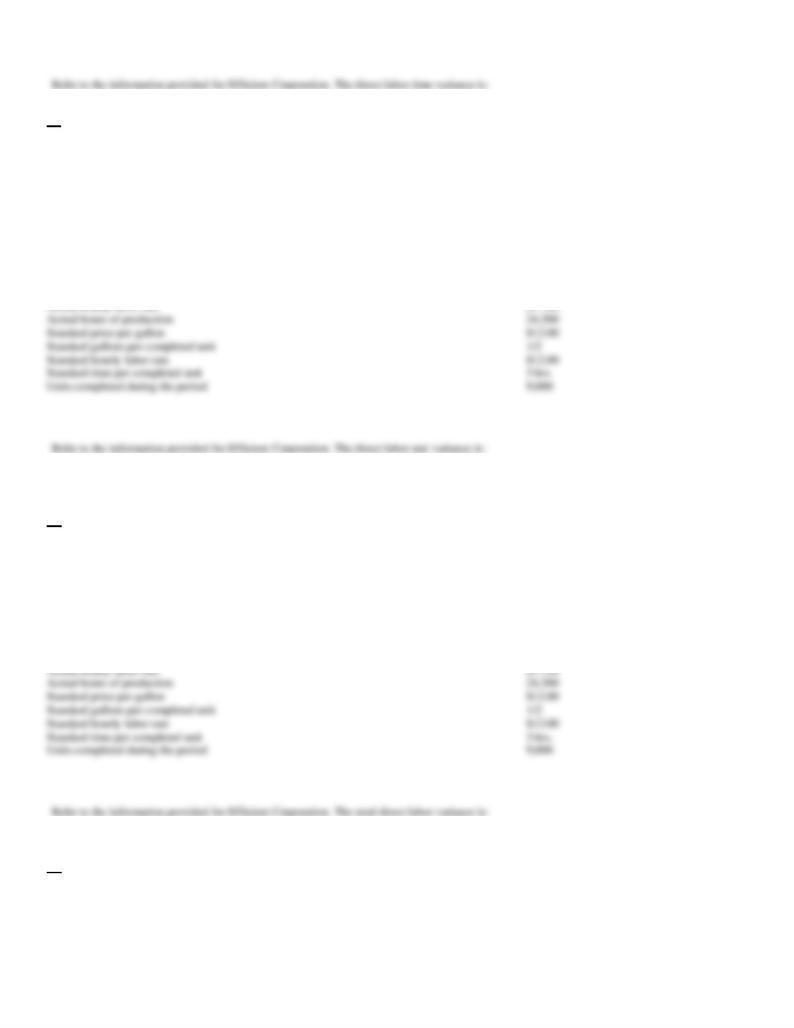
A. $31,725 favorable.
B. $32,400 favorable.
C. $89,100 unfavorable.
D. $121,500 unfavorable.
118. Efficient Corporation uses a standard cost system. The following information was provided for the period
that just ended:
Actual price per gallon
$11.75
Actual gallons of material used
5,000
A. $135,000 unfavorable.
B. $89,100 favorable.
C. $89,100 unfavorable.
D. $121,500 unfavorable.
119. Efficient Corporation uses a standard cost system. The following information was provided for the period
that just ended:
Actual price per gallon
$11.75
Actual gallons of material used
5,000
A. $216,000 favorable.
B. $32,400 favorable.
C. $89,100 unfavorable.
D. $121,500 unfavorable.

120. Frogue Corporation uses a standard cost system. The following information was provided for the period
that just ended:
Actual price per kilogram
$2.50
Actual kilograms of material used
31,000
Actual hourly labor rate
$18.10
Actual hours of production
4,900 labor hrs.
Standard price per kilogram
$2.80
A. $6,500 unfavorable.
B. $9,000 unfavorable.
C. $9,000 favorable.
D. $6,500 favorable.
121. Frogue Corporation uses a standard cost system. The following information was provided for the period
that just ended:
Actual price per kilogram
$2.50
Actual kilograms of material used
31,000
Actual hourly labor rate
$18.10
Actual hours of production
4,900 labor hrs.
Standard price per kilogram
$2.80
A. $6,000 favorable.
B. $2,100 favorable.
C. $2,100 unfavorable.
D. $6,000 unfavorable.
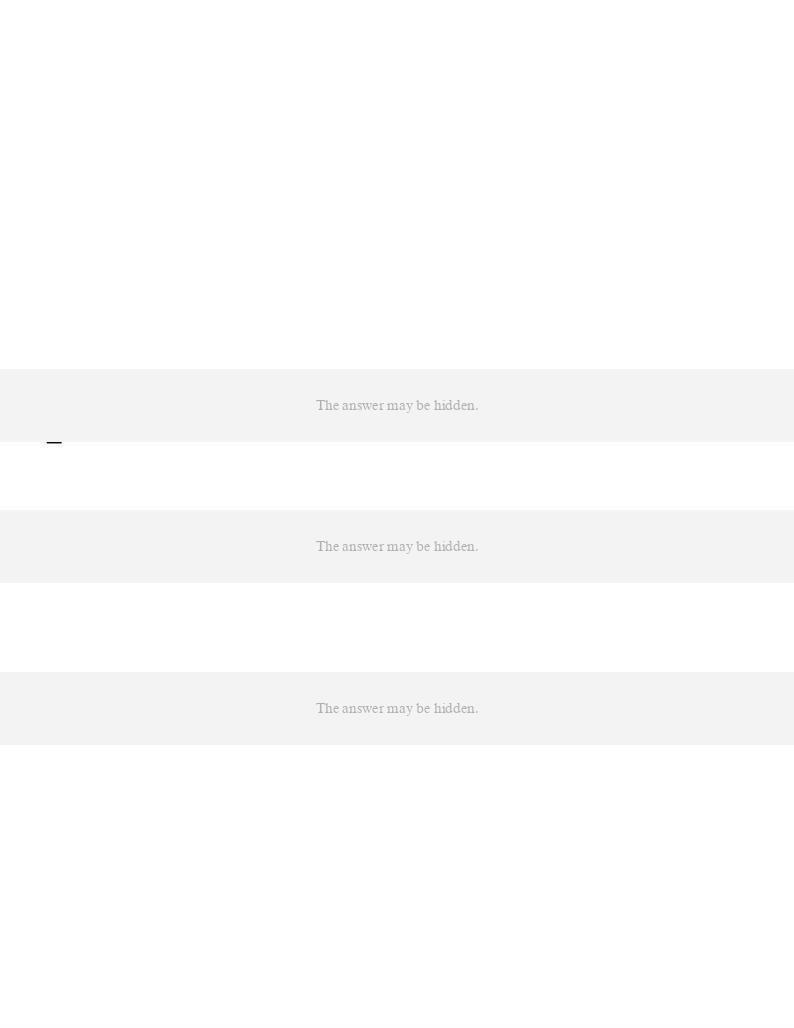
122. Frogue Corporation uses a standard cost system. The following information was provided for the period
that just ended:
Actual price per kilogram
$2.50
Actual kilograms of material used
31,000
Actual hourly labor rate
$18.10
Actual hours of production
4,900 labor hrs.
Standard price per kilogram
$2.80
Standard kilograms per completed unit
6 kilograms
Standard hourly labor rate
$18.00
Standard time per completed unit
1 hr.
Actual total factory overhead
$34,900
Actual fixed factory overhead
$18,000
Standard fixed factory overhead rate
$1.20 per labor hour
Standard variable factory overhead rate
$3.80 per labor hour
Maximum plant capacity
15,000 hours
Units completed during the period
5,000
123. If the wage rate paid per hour differs from the standard wage rate per hour for direct labor, the variance is
124. If the actual direct labor hours spent producing a commodity differ from the standard hours, the variance is
125. The following data relate to direct labor costs for the current period of Executive Inc.:
Standard costs
6,000 hours at $12.00
Actual costs
7,500 hours at $11.60
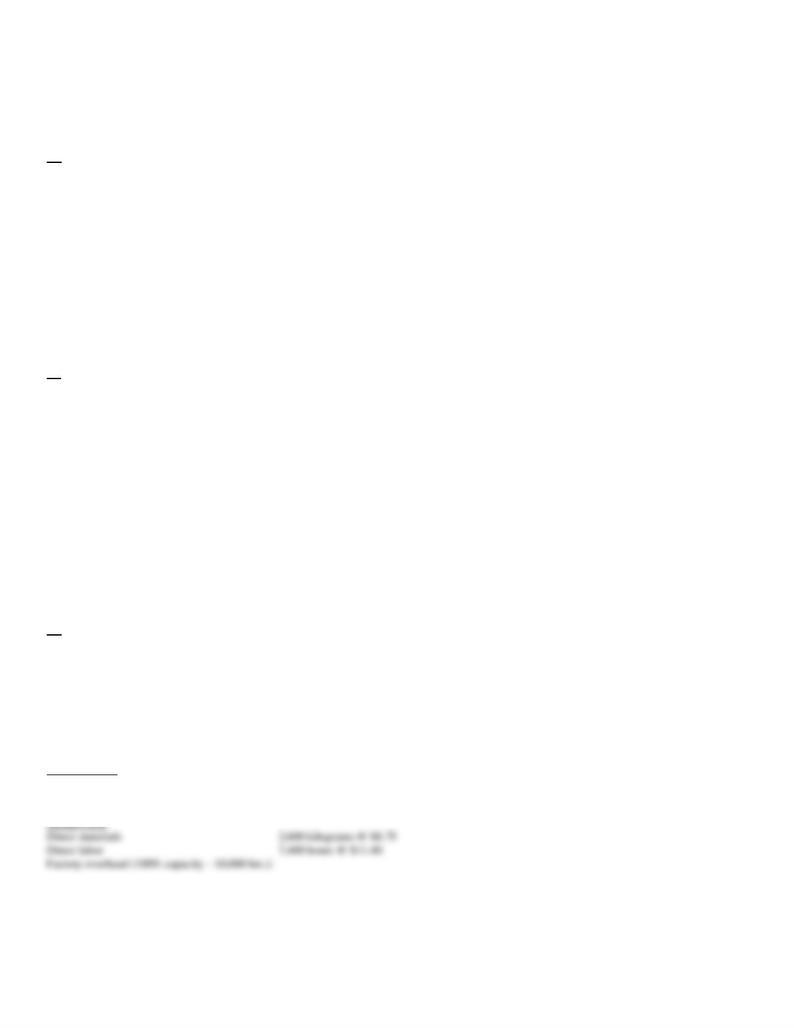
Refer to the information provided for Executive Inc. What is the direct labor time variance?
A. $17,400 favorable
B. $17,400 unfavorable
C. $18,000 favorable
D. $18,000 unfavorable
126. The following data relate to direct labor costs for the current period of Executive Inc.:
Standard costs
6,000 hours at $12.00
Actual costs
7,500 hours at $11.60
Refer to the information provided for Executive Inc. What is the direct labor rate variance?
A. $3,000 unfavorable
B. $3,000 favorable
C. $2,400 unfavorable
D. $2,400 favorable
127. The following data relate to direct labor costs for the current period:
Standard costs
36,000 hours at $23.50
Actual costs
35,000 hours at $23.00
What is the direct labor time variance?
A. $23,000 unfavorable
B. $23,500 unfavorable
C. $23,500 favorable
D. $23,000 favorable
128. Answer Corporation uses standard cost system. The standard costs and actual costs for direct materials,
direct labor, and factory overhead for the manufacture of 2,500 units of product are as follows:
Standard Costs
Direct materials
2,500 kilograms @ $8
Direct labor
7,500 hours @ $12
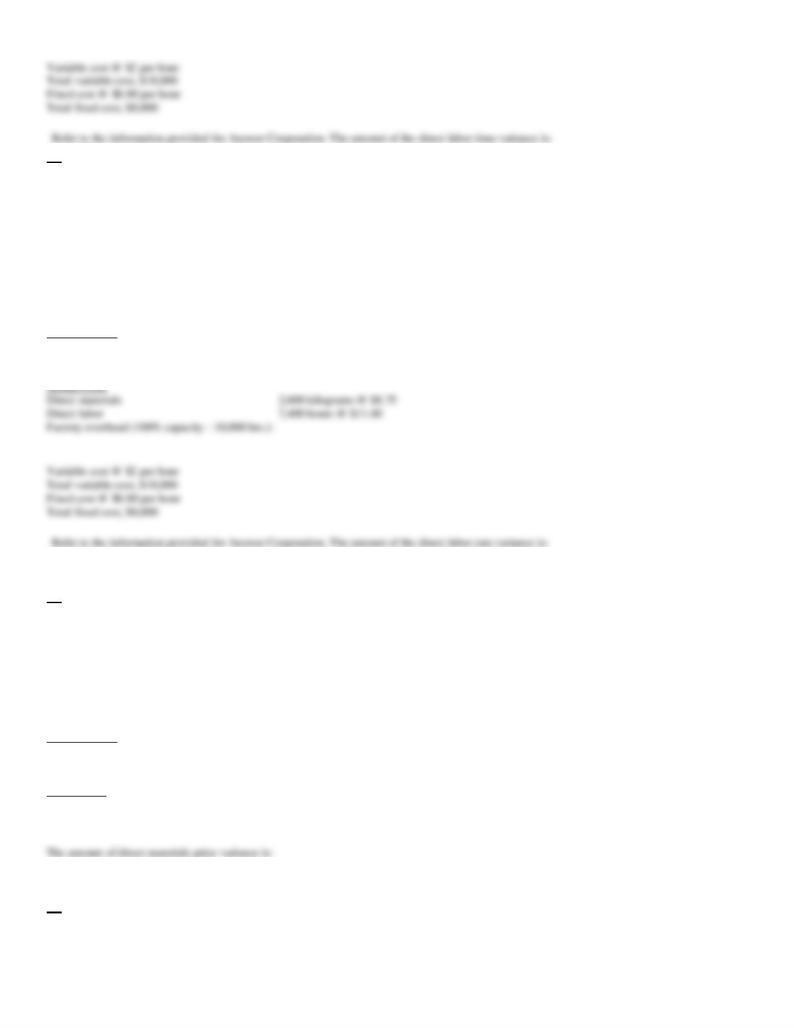
A. $1,200 favorable.
B. $1,140 unfavorable.
C. $1,200 unfavorable.
D. $1,140 favorable.
129. Answer Corporation uses standard cost system. The standard costs and actual costs for direct materials,
direct labor, and factory overhead for the manufacture of 2,500 units of product are as follows:
Standard Costs
Direct materials
2,500 kilograms @ $8
Direct labor
7,500 hours @ $12
A. $4,440 unfavorable.
B. $4,500 favorable.
C. $4,440 favorable.
D. $4,500 unfavorable.
130. The standard costs and actual costs for direct materials for the manufacture of 2,500 actual units of product
are as follows:
Standard Costs
Direct materials (per completed unit)
1.04 kilograms @$8.75
Actual Costs
Direct materials
2,500 kilograms @ $8
A. $1,875 unfavorable.
B. $1,950 favorable.
C. $1,875 favorable.
D. $1,950 unfavorable.

131. The standard costs and actual costs for direct materials, direct labor, and factory overhead for the
manufacture of 2,500 units of product are as follows:
Standard Costs
Direct labor
7,500 hours @ $12
Actual Costs
Direct labor
7,400 hours @ $11.40
The amount of the direct labor time variance is:
A. $1,200 favorable.
B. $1,140 unfavorable.
C. $1,200 unfavorable.
D. $1,140 favorable.
132. The following data relate to direct labor costs for the current period:
Standard costs
9,000 hours at $5.50
Actual costs
8,750 hours at $5.25
What is the direct labor rate variance?
A. $2,250.00 unfavorable
B. $2,187.50 unfavorable
C. $2,250.00 favorable
D. $2,187.50 favorable
133. The following data is given for the Walker Company:
Standard hours allowed per completed unit
4.5
Actual labor hours worked
4,560
Actual total labor costs
$62,928
Overhead:
Actual and budgeted fixed overhead
$27,000
Standard variable overhead rate
$3.50 per standard direct labor hour
Actual variable overhead costs
$15,500

Overhead is applied on standard labor hours.
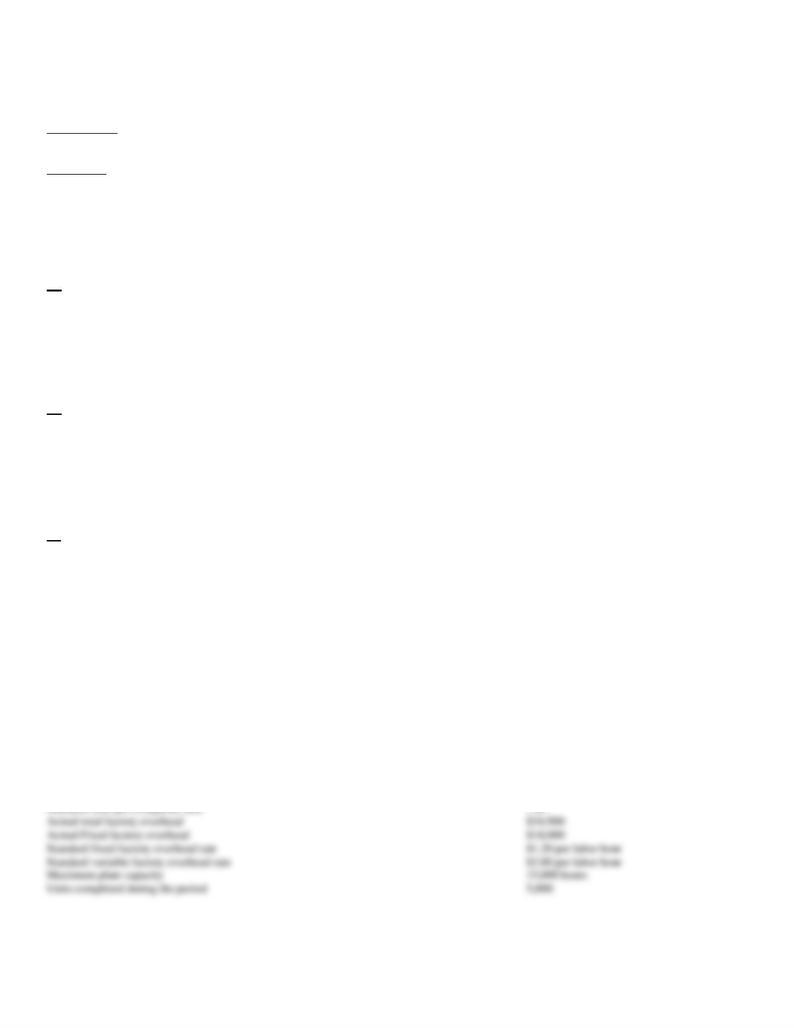
139. The standard costs and actual costs for direct labor for the manufacture of 2,500 actual units of product are
as follows:
Standard Costs
Direct labor
7,500 hours @ $12
Actual Costs
Direct labor
7,400 hours @ $11.40
The amount of the direct labor rate variance is:
A. $4,440 unfavorable.
B. $4,500 favorable.
C. $4,440 favorable.
D. $4,500 unfavorable.
140. The formula to compute direct material quantity variance is:
A. actual costs – standard costs.
B. standard costs – actual costs.
C. (actual quantity ´ standard price) – standard costs.
D. actual costs – (standard price ´ standard costs).
141. Which of the following would not lend itself to applying direct labor variances?
A. Computer help desk operator
B. Administrative assistant
C. Customer service personnel
D. Telemarketer
142. Frogue Corporation uses a standard cost system. The following information was provided for the period
that just ended:
Actual price per kilogram
$3.00
Actual kilograms of material used
31,000
Actual hourly labor rate
$18.20
Actual hours of production
4,900 labor hours
Standard price per kilogram
$2.80
Standard kilograms per completed unit
6 kilograms
Standard hourly labor rate
$18.00
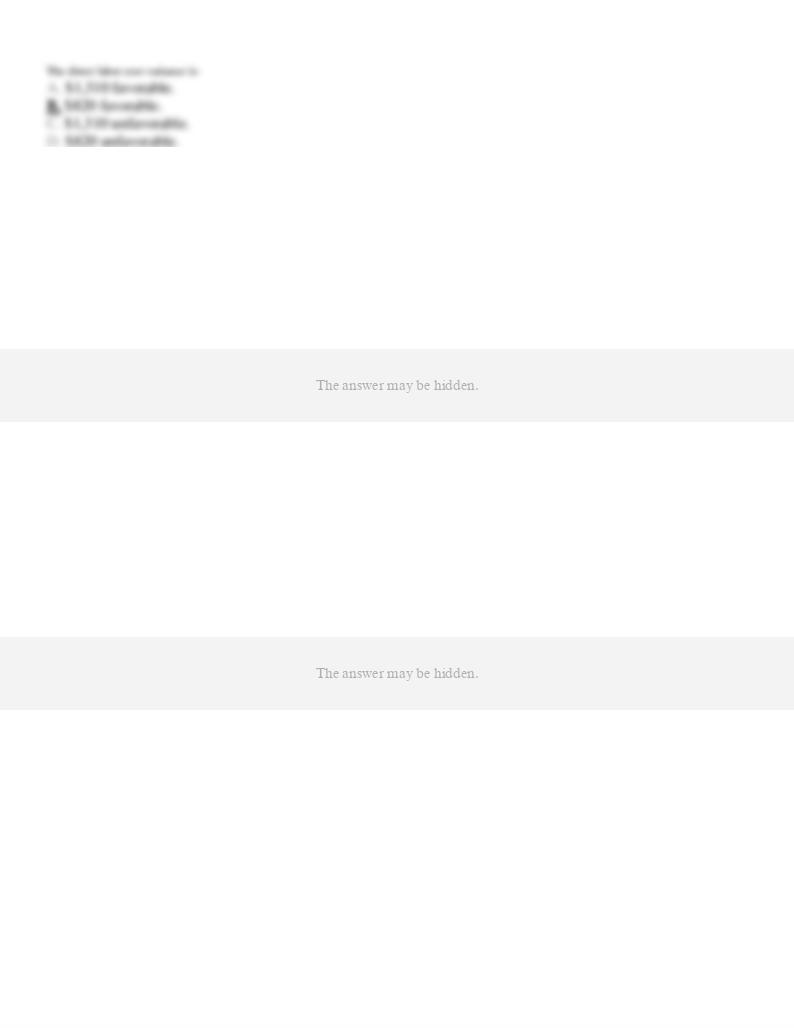
143. The standard fixed factory overhead rate is based on 100% capacity of 120,000 machine hours for
Thompson Inc. The standard costs and the actual costs of factory overhead for the production of 25,000 units
during March were as follows:
Actual: Factory overhead
$950,000
Standard: 100,000 hours at $9.00
900,000
144. The standard fixed factory overhead rate is based on 100% capacity of 50,000 direct labor hours. The
standard costs and the actual costs for factory overhead for the production of 8,000 units during the current
month were as follows:
Standard:
40,000 hours at $3
$120,000
Actual:
Factory overhead
(41,000 direct labor hours)
131,200
145. The standard factory overhead rate is $7.50 per machine hour ($6.20 for variable factory overhead and
$1.30 for fixed factory overhead) based on 100% capacity of 80,000 machine hours. The standard cost and the
actual cost of factory overhead for the production of 15,000 units during August were as follows:
Actual:
Variable factory overhead
$360,000
Fixed factory overhead
104,000
Standard:
60,000 hours at $7.50
450,000

What is the amount of the fixed factory overhead volume variance?
A. $26,000 unfavorable
B. $12,000 favorable
C. $26,000 favorable
D. $12,000 unfavorable
146. It would be most appropriate to develop direct labor time standards for use in administrative activities
when the activity involves:
A. repetitive task that produces common output.
B. nonrepetitive task that produces common output.
C. top-level management.
D. task related to nonmeasurable output.
147. The standard costs and actual costs for direct materials, direct labor, and factory overhead for the
manufacture of 2,500 units of product are as follows:
Standard Costs
Direct materials
2,500 kilograms @ $8
Direct labor
7,500 hours @ $12
A. $2,000 favorable.
B. $2,500 favorable.
C. $2,500 unfavorable.
D. $2,000 unfavorable.
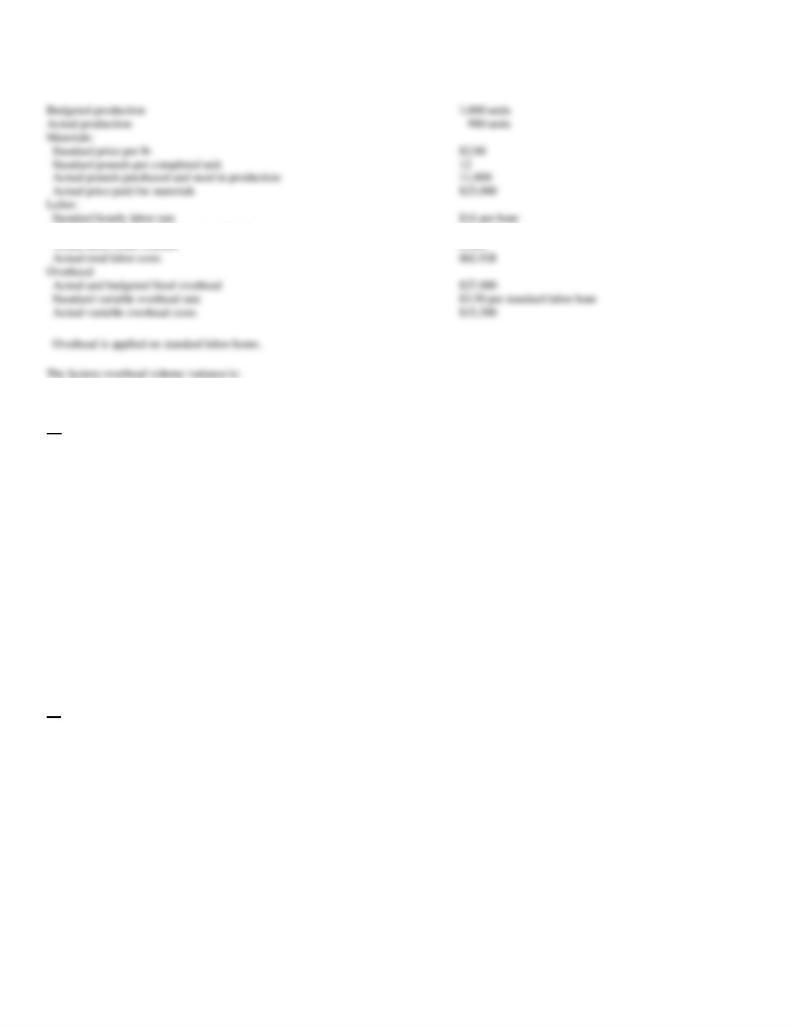
148. The following data is given for the Walker Company:
Standard hours allowed per completed unit
4.5
A. $65 unfavorable.
B. $65 favorable.
C. $540 unfavorable.
D. $540 favorable.
149. The standard factory overhead rate of Quaker Inc. is $10 per direct labor hour ($8 for variable factory
overhead and $2 for fixed factory overhead) based on 100% capacity of 30,000 direct labor hours. The standard
cost and the actual cost of factory overhead for the production of 5,000 units during May were as follows:
Standard:
25,000 hours at $10
$250,000
Actual:
Variable factory overhead
202,500
Fixed factory overhead
60,000
Refer to the information provided for Quaker Inc. What is the amount of the fixed factory overhead volume variance?
A. $12,500 favorable
B. $10,000 unfavorable
C. $12,500 unfavorable
D. $10,000 favorable
150. The standard factory overhead rate of Quaker Inc. is $10 per direct labor hour ($8 for variable factory
overhead and $2 for fixed factory overhead) based on 100% capacity of 30,000 direct labor hours. The standard
cost and the actual cost of factory overhead for the production of 5,000 units during May were as follows:
Standard:
25,000 hours at $10
$250,000
Actual:
Variable factory overhead
202,500
Fixed factory overhead
60,000

Refer to the information provided for Quaker Inc. What is the amount of the variable factory overhead controllable variance?
A. $10,000 favorable
B. $2,500 unfavorable
C. $10,000 unfavorable
D. $2,500 favorable
152. The standard factory overhead rate is $7.50 per machine hour ($6.20 for variable factory overhead and
$1.30 for fixed factory overhead) based on 100% capacity of 80,000 machine hours. The standard cost and the
actual cost of factory overhead for the production of 15,000 units during August were as follows:
Actual:
Variable factory overhead
$360,000
Fixed factory overhead
104,000
Standard:
60,000 hours at $7.50
450,000

156. Standard Corporation uses a standard cost system. The following information was provided for the period
that just ended:
Standard time per completed unit
3 hrs.
Actual total factory overhead
$108,000
Fixed factory overhead
$60,000
Standard fixed factory overhead rate
$2.00 per labor hour
Standard variable factory overhead rate
$1.50 per labor hour
Normal capacity
30,000 hours
Plant operated during the period
28,000 hours
Units completed during the period
9,000
158. Assuming that the standard fixed overhead rate is based on full capacity, the cost of available but unused
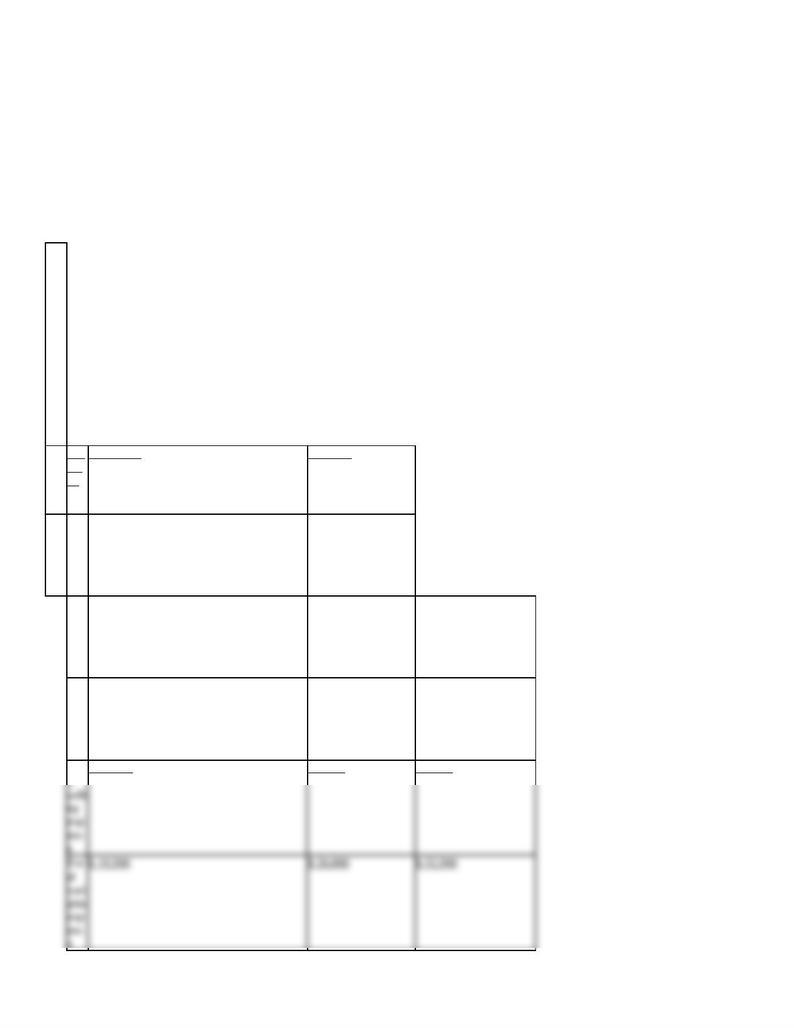
160. Prepare a monthly flexible selling expense budget for Prater Company for sales volumes of $300,000,
$400,000, and $500,000, based on the following data:
Sales commissions
5% of sales
Sales manager's salary
$70,000 per month
Advertising expense
$75,000 per month
Shipping expense
1% of sales
Miscellaneous selling expense
$2,100 per month plus 1/2% of sales
Prat
er
Co
mp
any
Mo
nthl
y
Sell
ing
Exp
ens
e
Bud
get
Sal
es
vol
um
e
$30
0,0
00
$400,000
$500,000
Var
iabl
e
exp
ens
e:
Sal
es
co
mm
issi
ons
$ 15,000
$ 20,000
$ 25,000
Shi
ppi
ng
exp
ens
e
3,000
4,000
5,000
Mis
1,500
2,000
2,500
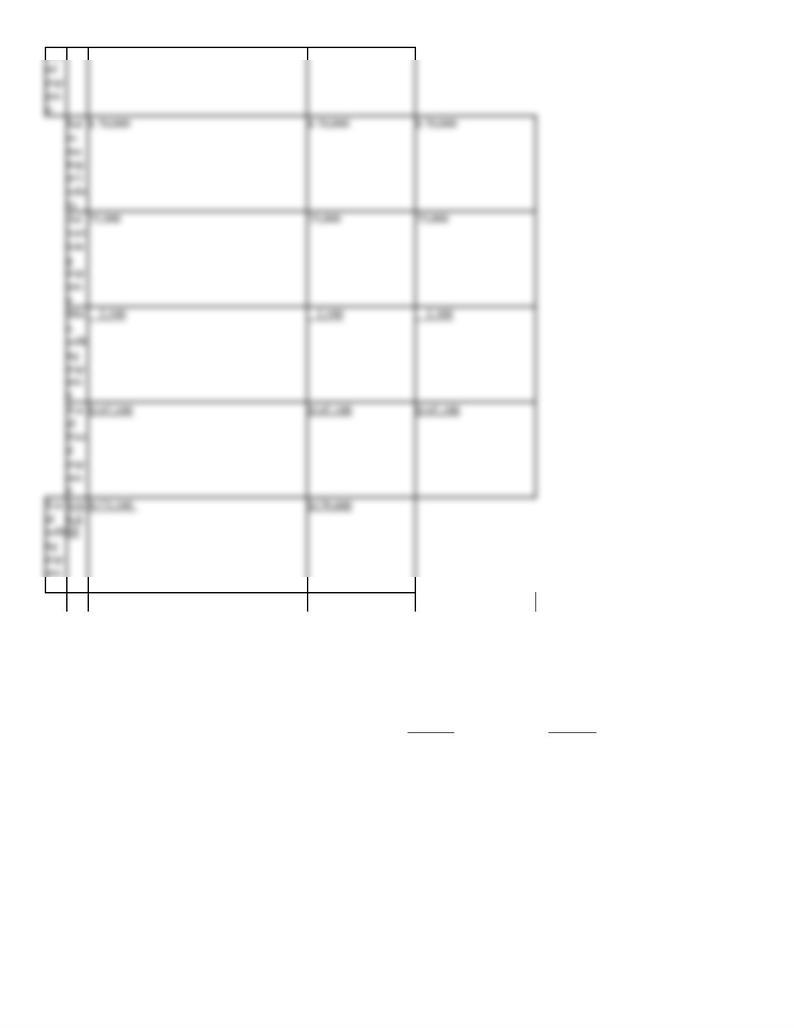
Fix
e
161. Based on the following production and sales data of Jackson Co. for March of the current year, prepare (a)
a sales budget and (b) a production budget.
Product T
Product X
Estimated inventory, March 1
26,000 units
18,000 units
Desired inventory, March 31
32,000 units
15,000 units
Expected sales volume:
Area I
320,000 units
260,000 units
Area II
190,000 units
130,000 units
Unit sales price
$4
$12
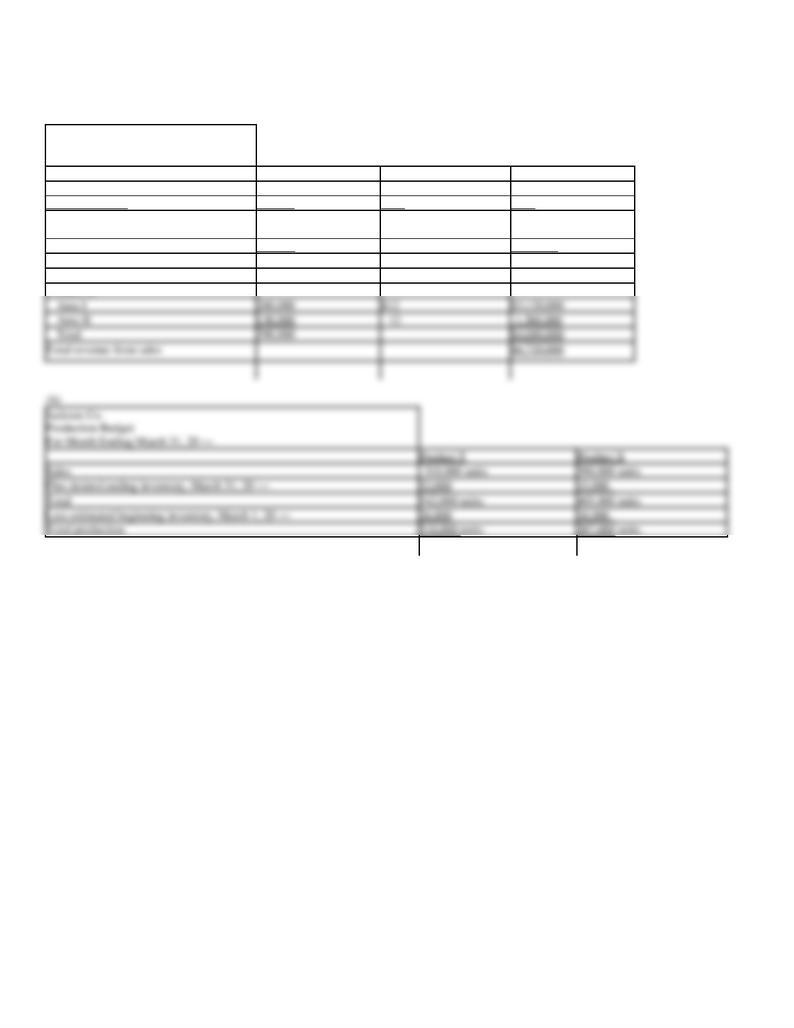
(a)
Jackson Co.
Sales Budget
For Month Ending March 31, 20 —
Unit
Unit
Sales
Selling
Total
Product and Area
Volume
Price
Sales
Product T:
Area I
320,000
$4
$1,280,000
Area II
190,000
4
760,000
Total
510,000
$2,040,000
Product X:

162. Merle Company manufactures two models of Television, TV20 and TV27. Based on the following
production data for April of the current year, prepare a production budget for April.
TV20
TV27
Esti
mate
d
inve
ntory
(unit
s),
April
1
1,700
2,500
Desir
ed
inve
ntory
(unit
s),
2,500
2,500
163. Brown Inc.’s production budget for Product X for the year ended December 31 is as follows:
Product X
Sales
640,000 units
Plus desired ending inventory
85,000
Total
725,000
Less estimated beginning inventory, Jan. 1
90,000
Total production
635,000
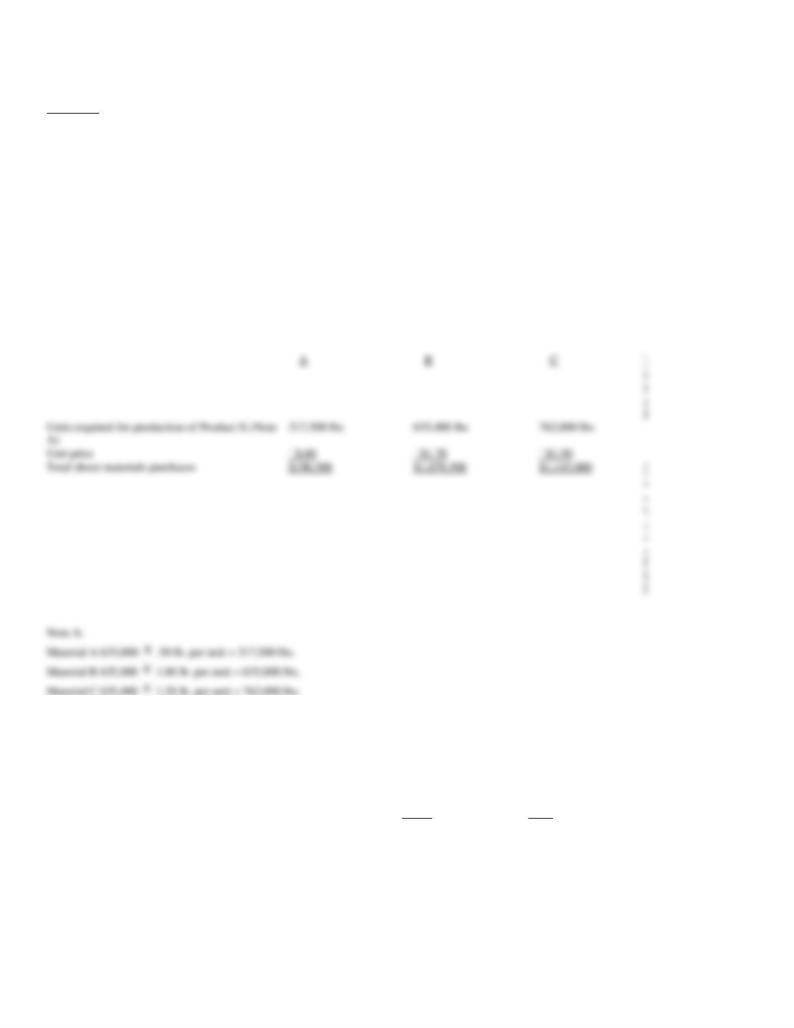
In Brown's production operations, Materials A, B, and C are required to make Product X. The quantities of direct materials expected to be used for
each unit of product are as follows:
Product X
Material A .50 pound per unit
Material B 1.00 pound per unit
Material C 1.20 pound per unit
The prices of direct materials are as follows:
Material A $0.60 per pound
Material B $1.70 per pound
Material C $1.50 per pound
Prepare a direct materials purchases budget for Product X.
Direct Materials
Purchases Budget
164. The treasurer of Unisyms Company has accumulated the following budget information for the first two
months of the coming year:
March
April
Sales
$450,000
$520,000
Manufacturing costs
290,000
350,000
Selling and administrative expenses
41,400
46,400
Capital additions
250,000
—-
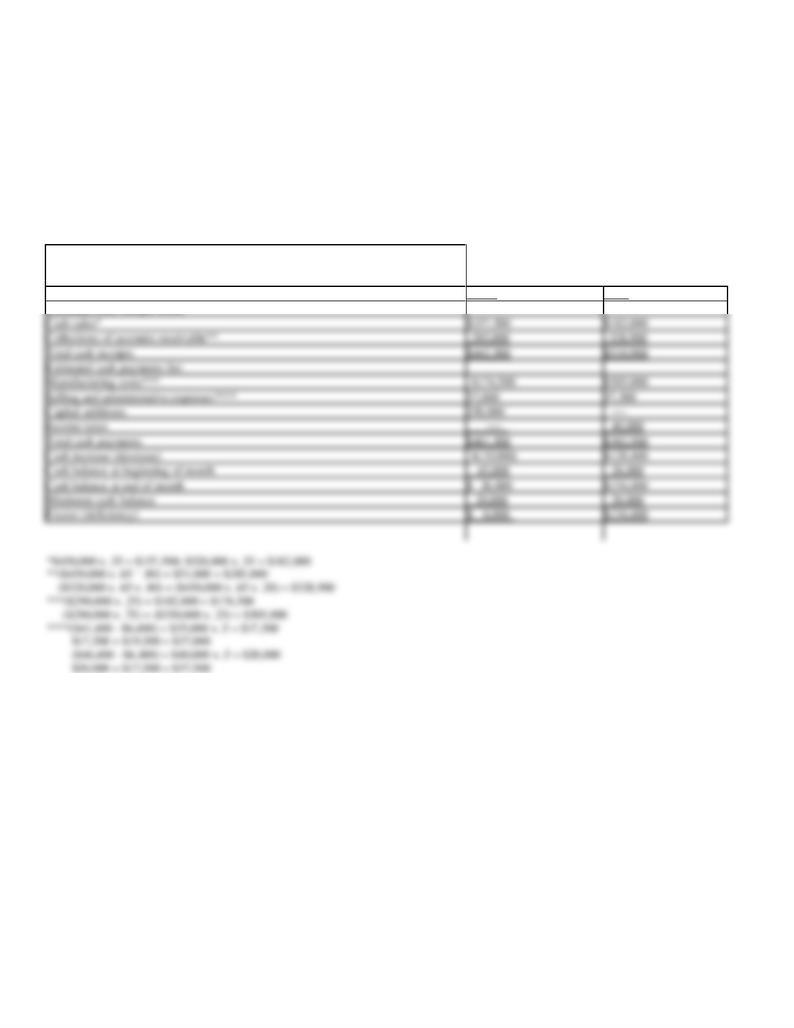
The company expects to sell about 35% of its merchandise for cash. Of sales on account, 80% are expected to be collected in full in the month of the
sale and the remainder in the month following the sale. One-fourth of the manufacturing costs are expected to be paid in the month in which they are
incurred and the other three-fourths in the following month. Depreciation, insurance, and property taxes represent $6,400 of the probable monthly
selling and administrative expenses. Insurance is paid in February, and a $40,000 installment on income taxes is expected to be paid in April. Of the
remainder of the selling and administrative expenses, one-half are expected to be paid in the month in which they are incurred, with the balance paid
in the following month. Capital additions of $250,000 are expected to be paid in March.
Current assets as of March 1 are composed of cash of $45,000 and accounts receivable of $51,000. Current liabilities as of March 1 are composed of
accounts payable of $121,500 ($102,000 for materials purchases and $19,500 for operating expenses). Management desires to maintain a minimum
cash balance of $20,000.
Prepare a monthly cash budget for March and April.
Unisyms Company
Cash Budget
For the Two Months Ending April 30, 20 —
March
April
Estimated cash receipts from:
165. Trapp Co. was organized on August 1 of the current year. Projected sales for the next three months are as
follows:
August
$100,000
September
185,000
October
225,000
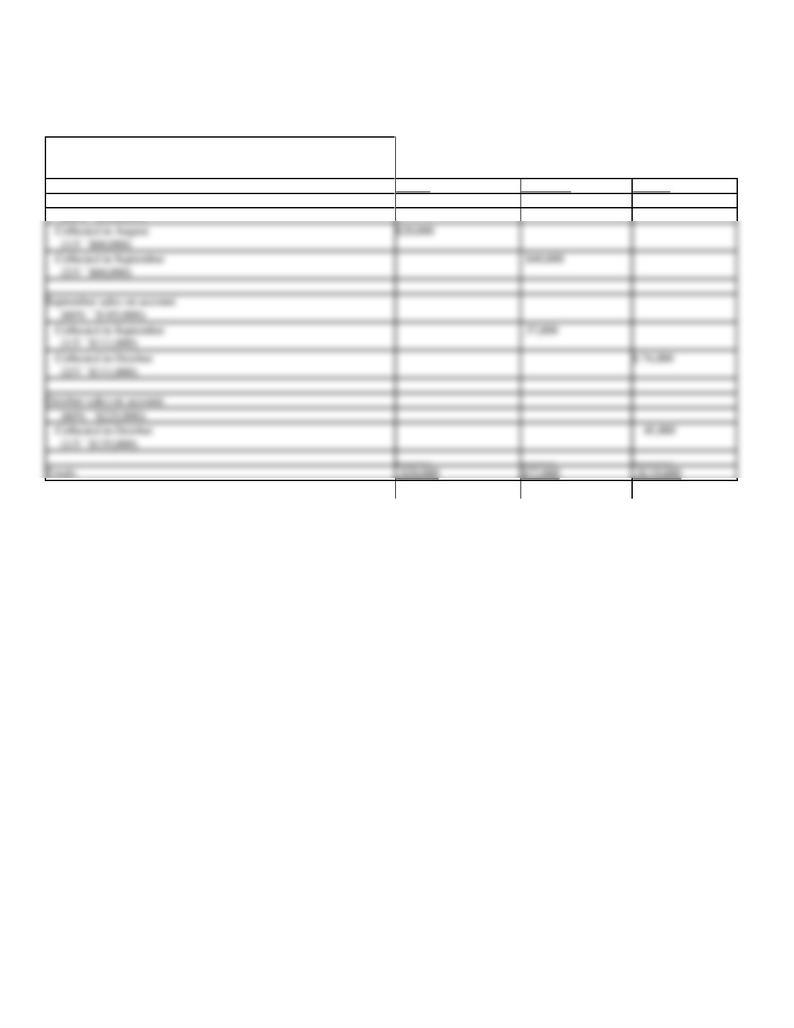
The company expects to sell 40% of its merchandise for cash. Of the sales on account, one third are expected to be collected in the month of the sale
and the remainder in the following month.
Prepare a schedule indicating cash collections of accounts receivable for August, September, and October.
Trapp Co.
Schedule of Collections of Accounts Receivable
For Three Months Ending October 31, 20 —
August
September
October
August sales on account
(60% ´ $100,000):
166. Standard and actual costs for direct materials for the manufacture of 1,000 units of product were as
follows:
Actual costs
1,450 lbs. @ $8.10
Standard costs
1,500 lbs. @ $8.00
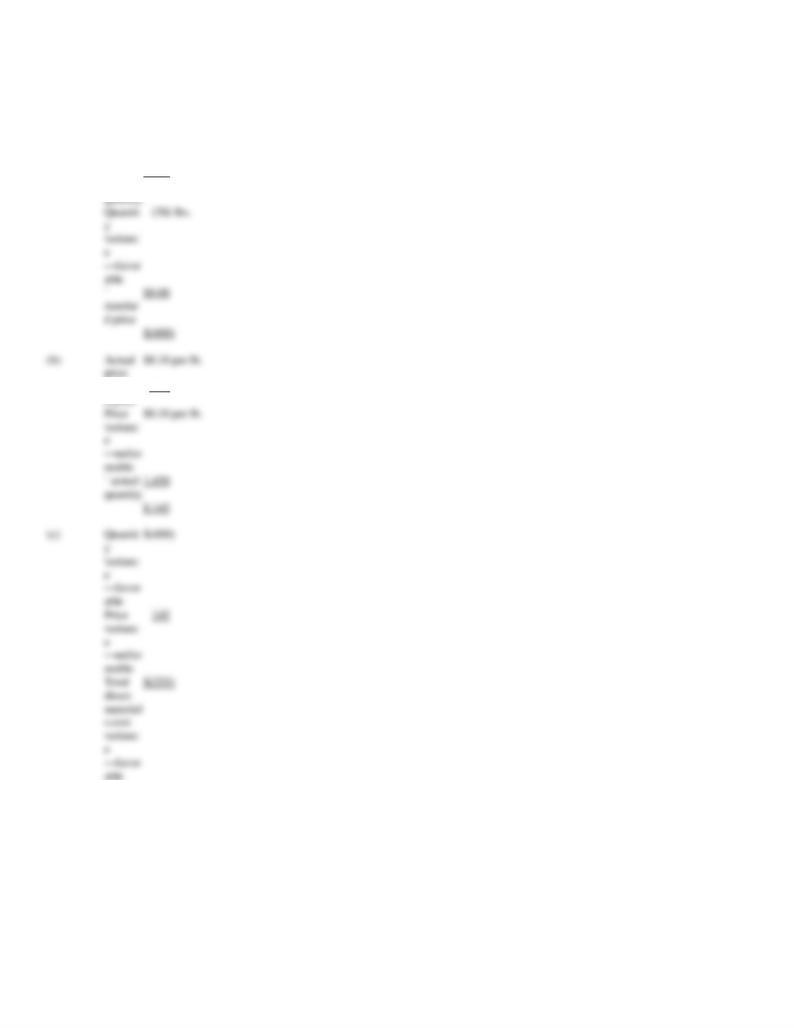
Determine the (a) quantity variance, (b) price variance, and (c) total direct materials cost variance.
(a)
Actual
quantity
1,450 lbs.
Standar
d
1,500 lbs.
Standar
8.00 per lb.
167. Compute the standard cost for one hat, based on the following standards for each hat:
Standard Material Quantity:
3/4 yard of fabric at $4.00 per yard
Standard Labor:
1 hour at $5.75 per hour
Factory Overhead:
$2.90 per direct labor hour

Standard Labor:
1 hour at $5.75 per hour
5.75
168. Standard and actual costs for direct materials for the manufacture of 1,000 units of product were as
follows:
Actual costs
1,550 lbs. @ $9.10
Standard costs
1,600 lbs. @ $9.00
Determine the (a) quantity variance, (b) price variance, and (c) total direct materials cost variance.
(a)
Actual quantity
1,550 lbs.
Standard quantity
1,600 lbs.
Quantity variance —favorable
(50) lbs.
´ standard price
$ 9.00
$(450)
(b)
Actual price
$9.10 per lb.
Standard price
9.00 per lb.
169. Standard and actual costs for direct labor for the manufacture of 1,000 units of product were as follows:
Actual costs
480 hours @ $18.00
Standard costs
485 hours @ $17.50
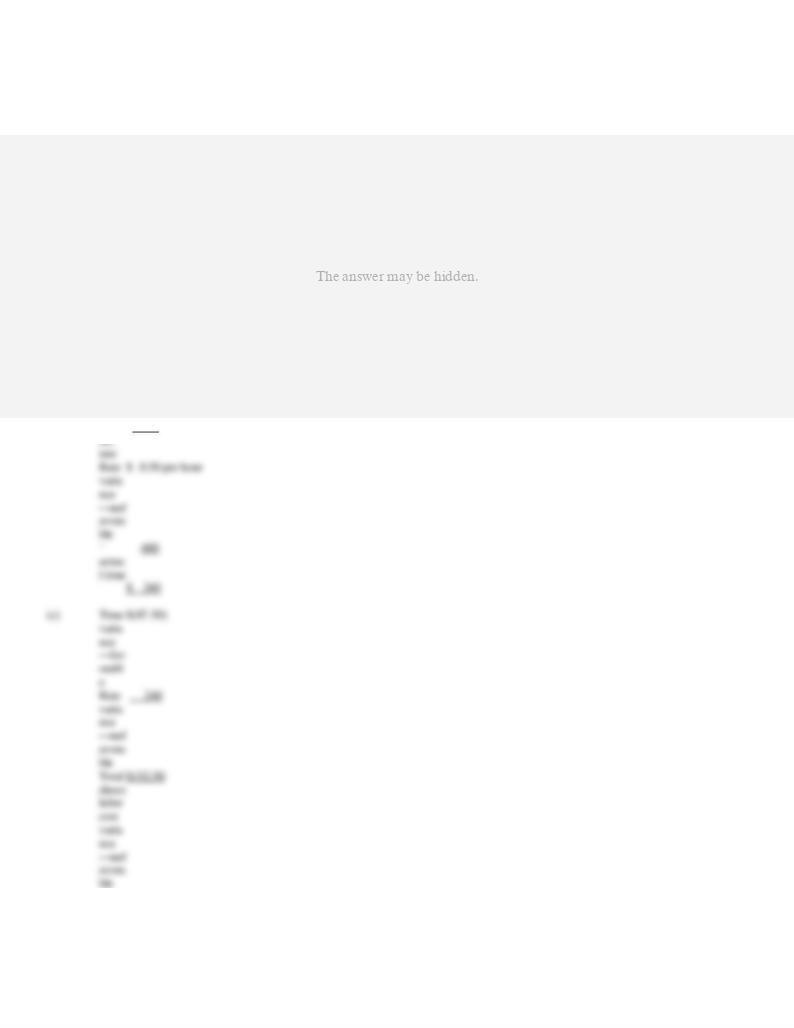
Determine the (a) time variance, (b) rate variance, and (c) total direct labor cost variance.
Stand
17.50 per hour

170. The standard factory overhead rate is $12 per machine hour ($10 for variable factory overhead and $2 for
fixed factory overhead) based on 100% capacity of 42,000 machine hours. The standard cost and the actual cost
of factory overhead for the production of 2,000 units were as follows:
Actual: Variable factory overhead
$350,500
Fixed factory overhead
84,000
Standard: 35,000 hours @ $12
420,000
Determine the (a) volume variance, (b) controllable variance, and (c) total factory overhead cost variance.
(a)
Productive capacity of 100%
42,000 hours
Standard for product produced
35,000 hours